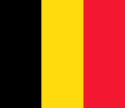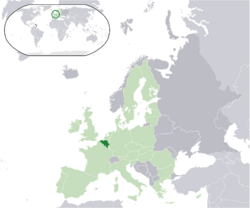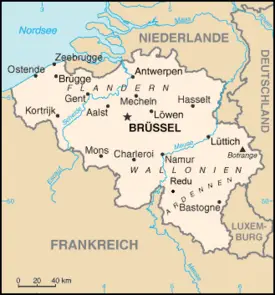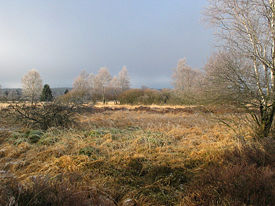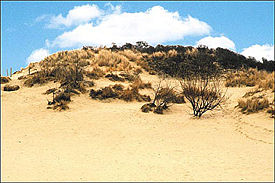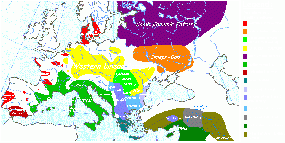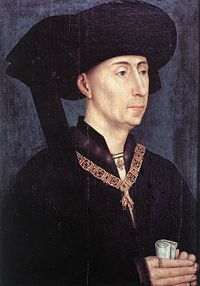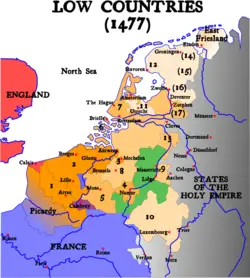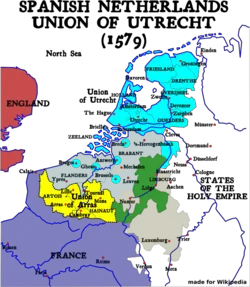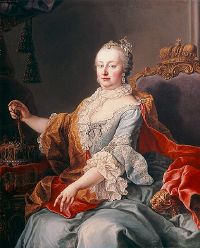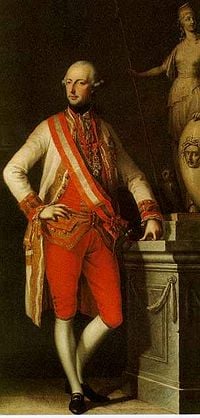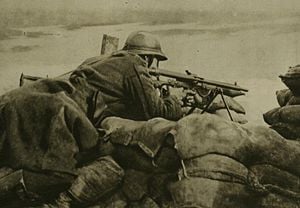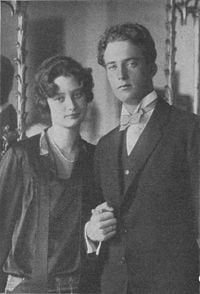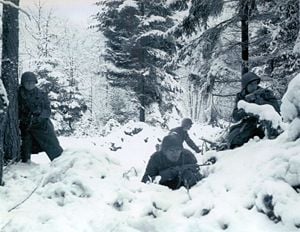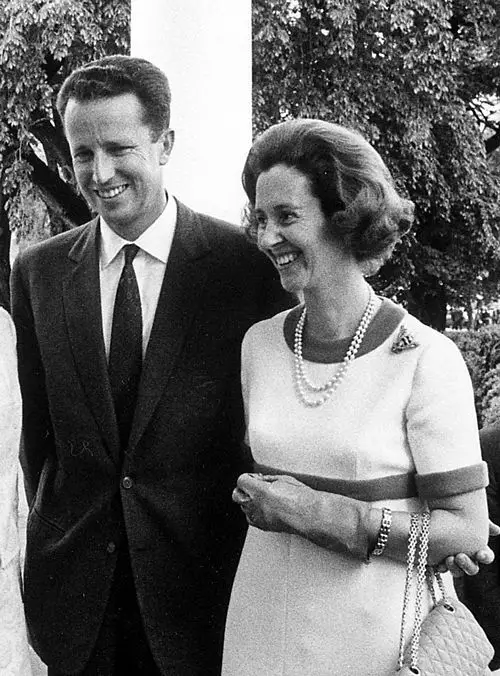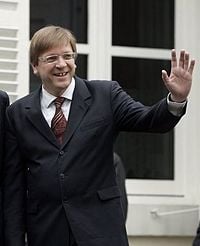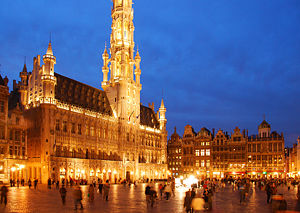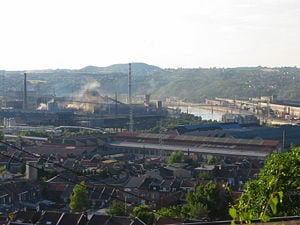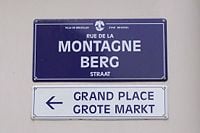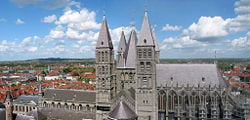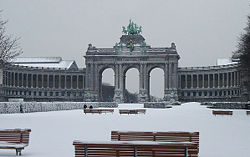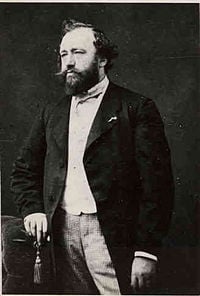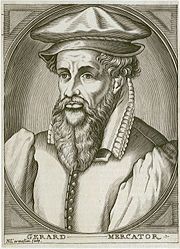Difference between revisions of "Belgium" - New World Encyclopedia
Mike Butler (talk | contribs) |
|||
| (85 intermediate revisions by 10 users not shown) | |||
| Line 1: | Line 1: | ||
| − | {{ | + | {{Approved}}{{Submitted}}{{Images OK}}{{Paid}}{{Copyedited}} |
| + | |||
{{Infobox Country or territory | {{Infobox Country or territory | ||
|native_name = {{nl icon}} ''Koninkrijk België''<br/>{{fr icon}} ''Royaume de Belgique''<br/>{{de icon}} ''Königreich Belgien'' | |native_name = {{nl icon}} ''Koninkrijk België''<br/>{{fr icon}} ''Royaume de Belgique''<br/>{{de icon}} ''Königreich Belgien'' | ||
| Line 5: | Line 6: | ||
|common_name = Belgium | |common_name = Belgium | ||
|image_flag = Flag of Belgium.svg | |image_flag = Flag of Belgium.svg | ||
| − | |image_coat = Belgium | + | |image_coat = Great coat of arms of Belgium.svg |
|symbol_type = Coat of arms | |symbol_type = Coat of arms | ||
|national_motto = ''Eendracht maakt macht''{{spaces|2}}<small>([[Dutch language|Dutch]])</small><br/>''L'union fait la force"''{{spaces|2}}<small>([[French language|French]])</small><br/>''Einigkeit macht stark''{{spaces|2}}<small>([[German language|German]])<br/>"Strength through Unity"</small> | |national_motto = ''Eendracht maakt macht''{{spaces|2}}<small>([[Dutch language|Dutch]])</small><br/>''L'union fait la force"''{{spaces|2}}<small>([[French language|French]])</small><br/>''Einigkeit macht stark''{{spaces|2}}<small>([[German language|German]])<br/>"Strength through Unity"</small> | ||
| Line 11: | Line 12: | ||
|map_caption = {{map_caption |region=[[Europe]] |subregion=the [[European Union]] |location_color=dark green |subregion_color=light green |region_color=dark grey |legend=}} | |map_caption = {{map_caption |region=[[Europe]] |subregion=the [[European Union]] |location_color=dark green |subregion_color=light green |region_color=dark grey |legend=}} | ||
|national_anthem = [[The Brabançonne|The "Brabançonne"]] | |national_anthem = [[The Brabançonne|The "Brabançonne"]] | ||
| − | |official_languages = [[Dutch language|Dutch]] | + | | official_languages = [[Dutch language|Dutch]]<br/>[[French language|French]]<br/>[[German language|German]] |
| − | |demonym = Belgian | + | | demonym = [[Belgians|Belgian]] |
| − | |capital = [[Brussels]] | + | | ethnic_groups = see [[#Demographics|Demographics]] |
| − | |latd=50 |latm= | + | | capital = [[City of Brussels|Brussels]] |
| − | |largest_settlement_type = metropolitan area | + | | latd = 50 |
| − | |largest_settlement = [[Brussels | + | | latm = 51 |
| − | |government_type = [[Federal constitutional monarchy]] | + | | latNS = N |
| − | |leader_title1 = [[Belgian monarchy|King]] | + | | longd = 4 |
| − | |leader_title2 = [[List of Prime Ministers of Belgium|Prime Minister]] | + | | longm = 21 |
| − | |leader_name1 = [[ | + | | longEW = E |
| − | |leader_name2 = [[ | + | | largest_settlement_type = metropolitan area |
| − | |area_km2 | + | | largest_settlement = [[Brussels]] |
| − | |area_sq_mi | + | | government_type = [[Federal constitutional monarchy|Federal]] [[parliamentary system|parliamentary democracy]] and [[Constitutional monarchy]]<ref name="cia"> {{cite web |title=Government of Belgium |work=The World Factbook |publisher=CIA}} </ref> |
| − | |area_rank = 139th | + | | leader_title1 = [[Belgian monarchy|King]] |
| − | |area_magnitude = 1 E10 | + | | leader_title2 = [[List of Prime Ministers of Belgium|Prime Minister]] |
| − | |percent_water = 6.4 | + | | leader_title3 = |
| − | |population_estimate = | + | | leader_name1 = [[Philippe of Belgium|Philippe]] (Filip) |
| − | + | | leader_name2 = [[Elio Di Rupo]] | |
| − | + | | legislature = [[Belgian Federal Parliament|Federal Parliament]] | |
| − | + | | upper_house = [[Belgian Senate|Senate]] | |
| − | + | | lower_house = [[Belgian Chamber of Representatives|Chamber of Representatives]] | |
| − | + | | area_km2 = 30,528 | |
| − | |url=http:// | + | | area_sq_mi = 11,787<!--Do not remove per [[WP:MOSNUM]]—> |
| − | + | | area_rank = 139th | |
| − | |accessdate= | + | | area_magnitude = 1 E10 |
| − | + | | percent_water = 6.4 | |
| − | |population_estimate_year = | + | | population_estimate = 11,007,020<ref> {{cite web |title=Total population as of January |publisher=Eurostat |url=http://epp.eurostat.ec.europa.eu/tgm/table.do?tab=table&language=en&pcode=tps00001&tableSelection=1&footnotes=yes&labeling=labels&plugin=1 |
| − | |population_estimate_rank = 76th | + | |accessdate=December 6, 2011}}</ref> |
| − | |population_census = 10,296,350 | + | | population_estimate_year = 2011 |
| − | |population_census_year = 2001 | + | | population_estimate_rank = 76th |
| − | |population_density_km2 | + | | population_census = 10,296,350 |
| − | |population_density_rank = | + | | population_census_year = 2001 |
| − | |population_density_sq_mi | + | | population_density_km2 = 354.7 |
| − | |GDP_PPP_year = | + | | population_density_rank = 33rd |
| − | |GDP_PPP = $ | + | | population_density_sq_mi = 918.6 <!--Do not remove [[WP:MOSNUM]]—> |
| − | |GDP_PPP_rank = | + | | GDP_PPP_year = 2010 |
| − | |GDP_PPP_per_capita = $ | + | | GDP_PPP = $394.346 billion<ref name=IMF>{{cite web|title=Belgium|publisher=International Monetary Fund}}</ref> |
| − | |GDP_PPP_per_capita_rank = | + | | GDP_PPP_rank = |
| − | |Gini = | + | | GDP_PPP_per_capita = $36,100<ref name=IMF/> |
| − | | | + | | GDP_PPP_per_capita_rank = |
| − | | | + | | GDP_nominal_year = 2010 |
| − | |Gini_category = <span style="color:# | + | | GDP_nominal = $465.676 billion<ref name=IMF/> |
| − | |HDI_year = | + | | GDP_nominal_rank = |
| − | |HDI = {{ | + | | GDP_nominal_per_capita = $42,630<ref name=IMF/> |
| − | |HDI_rank = | + | | GDP_nominal_per_capita_rank = |
| − | |HDI_category = <span style="color:# | + | | Gini = 28<ref name="Gini"> {{cite web |title=Distribution of family income—Gini index |work=The World Factbook |publisher=CIA |
| − | |sovereignty_type = [[Belgian Revolution|Independence]] | + | |url=https://www.cia.gov/library/publications/the-world-factbook/fields/2172.html |
| − | | | + | |accessdate=December 6, 2011 }}</ref> |
| − | + | | Gini_year = 2005 | |
| − | |established_date1 = | + | | Gini_category = <span style="color:#090;">low</span> |
| − | |established_event2 = [[Treaty of London, 1839| | + | | HDI_year = 2010 |
| − | |established_date2 = | + | | HDI = {{increase}} 0.867<ref name=""> {{cite web |title=Human Development Report 2010 |publisher=United Nations |year=2010 |url=http://hdr.undp.org/en/media/HDR_2010_EN_Table1.pdf |format=PDF |accessdate=December 7, 2011 }}</ref> |
| − | |accessionEUdate = | + | | HDI_rank = 18th |
| − | |EUseats = 24 | + | | HDI_category = <span style="color:#090;">very high</span> |
| − | |currency = | + | | sovereignty_type = [[Belgian Revolution|Independence]] |
| − | |currency_code = EUR | + | | established_event1 = Declared {{nowrap|from [[United Kingdom of the Netherlands|the Netherlands]]}} |
| − | |time_zone = [[Central European Time|CET]] | + | | established_date1 = 4 October 1830 |
| − | |utc_offset = +1 | + | | established_event2 = [[Treaty of London, 1839|Recognised]] |
| − | |time_zone_DST = [[Central European Summer Time|CEST]] | + | | established_date2 = 19 April 1839 |
| − | |utc_offset_DST = +2 | + | | accessionEUdate = 25 March 1957 |
| − | |cctld = [[.be]] | + | | EUseats = 24 |
| − | |calling_code = 32 | + | | currency = Euro ([[Euro sign|€]])<sup>1</sup> |
| − | |footnote1 = | + | | currency_code = EUR |
| − | |footnote2 = The [[.eu]] domain is also used, as it is shared with other | + | | time_zone = [[Central European Time|CET]] |
| + | | utc_offset = +1 | ||
| + | | time_zone_DST = [[Central European Summer Time|CEST]] | ||
| + | | utc_offset_DST = +2 | ||
| + | | drives_on = right | ||
| + | | cctld = [[.be]]<sup>2</sup> | ||
| + | | calling_code = [[Telephone numbers in Belgium|32]] | ||
| + | | footnote1 = Before 1999: [[Belgian franc]] (BEF). | ||
| + | | footnote2 = The [[.eu]] domain is also used, as it is shared with other European Union member states. | ||
}} | }} | ||
| − | The '''Kingdom of Belgium''' is a | + | The '''Kingdom of Belgium''' is a country in [[Western Europe|northwest Europe]] bordered by [[Netherlands|the Netherlands]], [[Germany]], [[Luxembourg]], and [[France]], with a short coastline on the [[North Sea]]. |
| + | |||
| + | Straddling the cultural boundary between [[Germanic Europe|Germanic]] and [[Latin Europe]], Belgium's two largest regions are Dutch-speaking [[Flanders]] in the north, with 58 percent of the population, and the French-speaking southern region of Wallonia, inhabited by 32 percent. The Brussels-Capital Region is an officially bilingual enclave within the Flemish and near the Walloon Region, and has ten percent of the population. | ||
| + | |||
| + | [[Christianity]] is traditionally seen as Belgium's majority religion, but by 2004, weekly Sunday church attendance had dropped to about 4 to 8 percent. The second largest religion practiced in Belgium is [[Islam]] (3.5 percent). | ||
| + | {{toc}} | ||
| + | Historically, Belgium, the Netherlands and Luxembourg were known as the [[Low Countries]], which once covered a somewhat larger area than the current [[Benelux]] group of states. From the end of the [[Middle Ages]] until the seventeenth century, it was a prosperous center of commerce and culture. From the sixteenth century until the Belgian revolution in 1830, many battles between European powers were fought in the area of Belgium, causing it to be dubbed "the battlefield of Europe" – a reputation strengthened by the World Wars of the twentieth century. | ||
| + | |||
| + | ==Geography== | ||
| + | [[Image:Be-map.png|thumb|275px|Main areas and places in Belgium.]] | ||
| + | [[Image:Hautes-Fagnes.jpg|thumb|275px|High Fens ''(Hautes Fagnes).'']] | ||
| + | [[Image:Hoge-Blekker.Koksijde.jpg|thumb|275px|Dunes in Koksijde, at the North Sea.]] | ||
| + | The name "Belgium" is derived from ''[[Gallia Belgica]],'' a [[Roman province]] in the northernmost part of [[Gaul]] that was inhabited by the ''[[Belgae]],'' a mix of [[Celts|Celtic]] and [[Germanic peoples|Germanic]] | ||
| + | |||
| + | Belgium shares borders with [[France]], [[Germany]], [[Luxembourg]], and the [[Netherlands]], and covers an area of 11,787 square miles (30,528 square kilometers), which is about the size of the state of [[Maryland]] in the [[United States]]. | ||
| + | |||
| + | Belgium is a low-lying country, with a broad coastal plain extending to the southeast from the [[North Sea]] and The Netherlands and rising gradually into the Ardennes hills and forests of the southeast, on which the [[Signal de Botrange]] forms the country's highest point at 2277 feet (694 meters). | ||
| − | + | Belgium has three main geographical regions: the coastal plain in the northwest, the central plateau, and the [[Ardennes]] uplands in the south-east. The coastal plain consists mainly of [[sand dune]]s and [[polder]]s. Polders are areas of land, close to or below sea level that have been reclaimed from the sea, from which they are protected by [[Dike (construction)|dikes]] or, further inland, by fields that have been drained with [[canal]]s. The second geographical region, the central plateau, lies further inland. This is a smooth, slowly rising area that has many fertile valleys and is irrigated by many waterways. Here one can also find rougher land, including caves and small [[gorge]]s. The third area is the thickly forested hills and plateaus of the Ardennes, which are more rugged and rocky with caves and small gorges, and offer much of Belgium's wildlife but little agricultural capability. Extending west into France, this area is connected to the [[Eifel]] in Germany by the [[High Fens]] plateau. | |
| − | |||
| − | |||
| − | |||
| − | |||
| − | | | ||
| − | |||
| − | |||
| − | |||
| − | |||
| − | |||
| − | |||
| − | |||
| − | |||
| − | |||
| − | |||
| − | |||
| − | |||
| − | |||
| − | |||
| − | |||
| − | |||
| − | |||
| − | |||
| − | |||
| − | |||
| − | |||
| − | |||
| − | |||
| − | |||
| − | |||
| − | |||
| − | |||
| − | |||
| − | |||
| − | |||
| − | |||
| − | |||
| − | |||
| − | |||
| − | |||
| − | |||
| − | |||
| − | |||
| − | |||
| − | |||
| − | |||
| − | |||
| − | |||
| − | |||
| − | |||
| − | |||
| − | |||
| − | |||
| − | |||
| − | |||
| − | |||
| − | |||
| − | |||
| − | |||
| − | |||
| − | |||
| − | |||
| − | |||
| − | |||
| − | |||
| − | |||
| − | |||
| − | The | + | The climate is [[Oceanic climate|maritime temperate]], with significant precipitation in all seasons. The average temperature is lowest in January (winter) at 37°F (3°C) and highest in July (summer) at 64°F (18°C) The average precipitation per month varies between 2.1 inches (54mm) in February or April, to 3.1 in (78mm) in July. |
| − | + | ||
| − | + | The low-lying plain of Flanders is drained by the Leie, Schelde, and Dender rivers flowing northeast to the Schelde [[estuary]], plus several [[shipping]] canals. The Ardennes is a plateau cut into by the [[Meuse River]] and its tributaries. | |
| − | + | ||
| − | + | Natural resources include construction materials, silica sand, and carbonates. | |
| − | + | ||
| − | + | Belgium's flora includes [[digitalis]], wild arum, [[hyacinth]], [[strawberry]], [[goldenrod]], [[lily of the valley]], and other plants common to temperate zones, while [[beech]] and [[oak]] are the predominant [[tree]]s. [[Boar]], [[fox]], [[badger]], [[squirrel]], [[weasel]], [[marten]], and [[hedgehog]] are still found in Belgium. Aquatic life includes [[pike]], [[carp]], trout, [[eel]], barbel, perch, smelt, chub, roach, bream, shad, sole, mussels, crayfish, and shrimp. | |
| − | + | ||
| − | + | Flooding is a threat along rivers and in areas of reclaimed coastal land, protected from the sea by concrete dikes. The environment is under intense pressure from human activities, including urbanization, a dense transportation network, industry, extensive [[animal breeding]], and [[crop]] [[cultivation]]. Air and water pollution have repercussions for neighboring countries. Uncertainties regarding federal and regional responsibilities have slowed progress in tackling environmental challenges. | |
| − | + | ||
| − | + | Brussels, the [[capital]] of [[Belgium]], was founded around 979, when Duke [[Charles, Duke of Lower Lotharingia|Charles]] transferred the relics of Saint Gudula from [[Moorsel]] to the Saint Gaugericus chapel in Brussels. The metropolitan area had between 2.1 to 2.6 million people in 2006. Brussels is considered the ''de facto'' capital of the [[European Union]] (EU), and hosts many of the its key institutions. [[NATO]], the [[Western European Union]] and [[EUROCONTROL]] are also headquartered in the city. | |
| − | |||
| − | |||
| − | |||
| − | |||
| − | |||
| − | |||
| − | |||
| − | |||
| − | |||
| − | |||
| − | |||
| − | |||
| − | |||
| − | |||
| − | |||
| − | |||
| − | |||
| − | |||
| − | |||
| − | |||
| − | |||
| − | |||
| − | |||
| − | |||
| − | |||
| − | |||
| − | |||
| − | |||
| − | |||
| − | |||
| − | |||
| − | |||
| − | |||
| − | |||
| − | |||
| − | |||
| − | |||
| − | |||
| − | |||
| − | |||
| − | |||
| − | |||
| − | |||
| − | |||
| − | |||
| − | |||
| − | |||
| − | |||
| − | |||
| − | |||
| − | |||
| − | |||
| − | |||
| − | |||
| − | |||
| − | |||
| − | |||
==History== | ==History== | ||
| − | + | [[Image:European Middle Neolithic.gif|thumb|285px|The distribution of some of the main culture complexes in [[Neolithic Europe]], ca. 4500 B.C.E.]] | |
| − | [[Image:Map-1477 Low Countries.png|thumb| | + | [[Image:Belgica.png|thumb|285px|The Roman province Gallia Belgica in around 120 C.E.]] |
| − | The | + | |
| − | + | ===Prehistory=== | |
| − | + | The oldest primitive flint tools found on the area of today's Belgium date to about 250,000 before present (BP). Evidence of [[Mousterian culture]] (c. 80,000–35,000 BP) has been found in the Ardennes caves in southern Belgium and in Belgian Limburg. A dug-out pine [[canoe]] dating to 8500 BP, the oldest vessel known, was found at Pesse. [[Neolithic]] remains can be found at [[Spiennes]] where there was a [[flint]] [[Mining|mine]]. Beaker culture, of the late Neolithic period (3300–2000 B.C.E.), left both megalithic and individual burial monuments and an array of collared flasks, buckets, bowls, battle-axes, and daggers. | |
| − | + | ||
| − | | | + | The first signs of [[Bronze Age]] activity in Belgium date from around 1750 B.C.E., with evidence of farmhouses, and stables. Cattle were the main livestock. From 500 B.C.E., [[Celt]]ic tribes settled in the region and traded with the [[Mediterranean]] world. Warrior chieftain graves at Hainaut, and Eigenbilzen were stocked with [[chariot]]s and harnesses, and [[bronze]] weapons. From c. 150 B.C.E., the first [[coin]]s came into use. |
| − | | | + | |
| − | |year= | + | The earliest named inhabitants of Belgium were the [[Belgae]] (after whom modern [[Belgium]] is named). The population covered a significant area of [[Gauls|Gaulish]] or [[Celt]]ic Europe, living in northern [[Gaul]] at the time of the Roman occupation. |
| − | + | ||
| − | | | + | ===Roman rule=== |
| + | In 54 B.C.E., the Belgae were over-run by the armies of [[Julius Caesar]], as described in his chronicle ''[[De Bello Gallico]].'' In this same work Julius Caesar referred to the [[Belgae]] as "the bravest of all the Gauls." He cited the arrival of [[List of Germanic peoples|Germanic]] tribes from the north and east. What is now Belgium flourished as a province of [[Rome]], which was much larger than the modern Belgium and included five cities: Nemetacum ([[Arras]]), Divodurum ([[Metz]]), Bagacum ([[Bavay]]), Aduatuca ([[Tongeren]]), Durocorturum ([[Reims]]). At the northeast was the neighboring province of [[Germania Inferior]]. | ||
| + | |||
| + | Resurging Germanic tribes and encroachment of the sea resulted in Romans abandoning forts in the area in the mid-third century. [[Julian]], Caesar of Gaul, waged wars in the Low Countries between 355 and 360 and was able to strengthen the Rhine border. A great invasion by [[Germanic tribes]] in 406–407 ended Roman occupation, and the [[Franks]] were given the task of defending the frontier. | ||
| + | |||
| + | ===Early Middle Ages=== | ||
| + | [[Image:Charlemagne-by-Durer.jpg|thumb|left|200px|A portrait of Charlemagne by [[Albrecht Dürer]] that was painted several centuries after Charlemagne's death.]] | ||
| + | [[Childeric I]] (437-481) the first king of the Merovingian Franks, established his capital at [[Tournai]], while his son [[Clovis I]] (466–511) extended the kingdom to include much of Gaul, and converted to [[Christianity]]. Christian scholars, mostly [[Ireland|Irish]] [[monk]]s, preached Christianity and started a wave of [[Religious conversion|conversion]]. The Merovingians were succeeded by the [[Carolingian Dynasty]]. After [[Charles Martel]] (686-741) countered the [[Moors|Moorish]] invasion from Spain, the King [[Charlemagne]] (742/7-814) who was born close to [[Liège (city)|Liège]]) brought a huge part of Europe under his rule and was [[Crown (headgear)|crowned]] the "[[Emperor]] of the [[Holy Roman Empire]]" by the Pope [[Leo III]] (800 in [[Aachen]]). | ||
| + | |||
| + | [[Arnulf of Carinthia]] (850-899) defeated the [[Vikings]] in 891 near [[Leuven]]. | ||
| + | The Frankish lands were eventually divided into [[France]] and the [[Holy Roman Empire]]. The parts of the [[County of Flanders]] stretching out west of the river [[Scheldt]] (Escaut in French) became part of France during the Middle Ages, but the remainders of the County of Flanders and the [[Low Countries]] were part of the Holy Roman Empire. | ||
| + | |||
| + | As the Holy Roman Emperors lost effective control of their domains in the eleventh and twelfth centuries, the territory more or less corresponding to the present Belgium was divided into mostly independent feudal principalities: the County of Flanders, Marquisate of Namur, Duchy of Brabant, County of Hainaut, Duchy of Limburg, Luxemburg, and the Bishopric of Liège. The rulers of these—both secular and spiritual—had a feudal relationship with the German king (the Holy Roman emperor). The count of Flanders held most of his land as the vassal of the French king, with the eastern part of his county being held in fealty to the German king. | ||
| + | |||
| + | During the eleventh and twelfth centuries, the [[Mosan art]] movement flourished in the region moving its centre from [[Cologne]] and [[Trier]] to [[Liège (city)|Liège]], [[Maastricht]] and [[Aachen]]. Some masterpieces of this [[Romanesque art]] are the [[shrine of the Three Kings at Cologne Cathedral]], the [[baptistry]] of [[Renier de Huy]] in Liège, the shrine of [[Saint Remacle]] in [[Stavelot]], the shrine of [[Saint Servatius]] in Maastricht or, [[Notger]]'s gospel in Liège. | ||
| + | |||
| + | In the thirteenth and fourteenth centuries, many cities gained their independence, there was huge trade within the Hanseatic League, huge [[Gothic architecture|gothic]] cathedrals and city halls were built. | ||
| + | |||
| + | ===Part of Burgundy=== | ||
| + | [[Image:Philip the good.jpg|thumb|right|200px|Philip the Good, painted c. 1450 by Rogier van der Weyden.]] | ||
| + | [[Image:Map-1477 Low Countries.png|thumb|250px|The [[Seventeen Provinces]] (orange, brown and yellow areas) and the [[Bishopric of Liège]] (green)]] | ||
| + | [[Image:Map-1579 Union of Utrecht.png|thumb|250px|Map of the Spanish Netherlands, the Union of Utrecht and the Union of Arras (1579).]] | ||
| + | By 1433, most of the Belgian and [[Luxembourg]]ian territory along with much of the rest of the [[Low Countries]] became part of [[Burgundy]] under [[Philip the Good]] (1396-1467). When [[Mary of Burgundy]], granddaughter of Philip the Good married [[Maximilian I, Holy Roman Emperor|Maximilian I]] (1459– 1519), the Low Countries became [[Habsburg]] territory. Their son, [[Philip I of Castile]] (Philip the Handsome) was the father of the later [[Charles V, Holy Roman Emperor|Charles V]] (1500–1558). The Holy Roman Empire was unified with [[Spain]] under the [[Habsburg Dynasty]] after Charles V inherited several domains. | ||
| + | |||
| + | Especially during the Burgundy period (the fifteenth and sixteenth centuries), [[Ypres]], [[Ghent]], [[Bruges]], [[Brussels]], and [[Antwerp]] took turns at being major [[Europe]]an centers for commerce, industry (especially textiles) and art. The [[Flemish Primitives]] were a group of [[painting|painters]] active primarily in the Southern Netherlands in the fifteenth and early sixteenth centuries (for example, [[Jan van Eyck|Van Eyck]] and [[Roger van der Weyden|van der Weyden]]). Flemish [[Tapestry|tapestries]] hung on the walls of castles throughout Europe. | ||
| + | |||
| + | ===The Seventeen Provinces=== | ||
| + | The [[Pragmatic Sanction of 1549]], issued by Holy Roman Emperor [[Charles V]] (1500–1558), established the [[Seventeen Provinces]] (or the Spanish Netherlands in its broad sense) as an entity separate from the empire and from France. This comprised all of the [[Netherlands]], [[Belgium]], and [[Luxembourg]] except for the lands of the [[Bishopric of Liège]]. However, the northern region now known as the Netherlands became increasingly [[Protestant]] ([[Calvinistic]]), while the south remained primarily [[Roman Catholic Church|Catholic]]. The schism resulted in the [[Union of Atrecht]] and the [[Union of Utrecht]] in 1579. When [[Philip II of Spain|Philip II]] (1527-1598), son of Charles ascended the Spanish throne, he tried to abolish Protestantism. | ||
| + | |||
| + | ===Eighty Years' War=== | ||
| + | Portions of the Netherlands revolted, beginning the [[Eighty Years' War]] (1568–1648), between the Netherlands and Spain. For the conquered [[Southern Netherlands]] the war ended in 1585 with the Fall of [[Antwerp]]. This can be seen as the start of Belgium as one region. That same year, the northern Low Countries (i.e. the Netherlands proper) seized [[independence]] in the [[Oath of Abjuration]] ''(Plakkaat van Verlatinghe)'' and started the [[Dutch Republic|United Provinces]] and the [[Dutch Golden Age]]. For them, the war lasted until 1648 (the [[Peace of Westphalia]]), when Spain recognized the independence of the Netherlands, but held onto the loyal and Catholic region of modern-day Belgium which was all that remained of the Spanish Netherlands. | ||
| + | |||
| + | ===Spanish rule=== | ||
| + | The [[Southern Netherlands]] remained under the rule of the Spanish Hapsburgs (1519-1713), although it enjoyed a large degree of autonomy. A governor-general, usually a Spanish royal family member, represented the king in Brussels. Local leaders held most positions on the Council of State, the Privy Council, and the Council of Finances. The president of the Privy Council became a kind of prime minister. The bishopric of [[Liège]] was ruled as a separate principality. | ||
| + | |||
| + | A revolt against Spain in 1567 and subsequent military campaigns harmed industrial activity in the south, and caused merchants and skilled artisans to leave. [[Amsterdam]] replaced [[Antwerp]] as the chief trading centre of Europe. To rebuild its economic base, Antwerp fostered silk weaving, diamond processing, and the production of fine linen, furniture, and lace. The [[Brueghel]]s, [[Peter Paul Rubens]] and [[Van Dyck]]'s [[baroque]] paintings were created during this period. | ||
| + | |||
| + | ===Austrian Habsburg rule=== | ||
| + | [[Image:Kaiserin Maria Theresia (HRR).jpg|thumb|left|200px|Maria Theresa.]] | ||
| + | [[Image:Joseph II.jpg|thumb|right|200px|Emperor Joseph II]] | ||
| + | In 1700, [[Charles II]] (1661–1700) died, ending the Spanish Habsburg dynasty, and a new conflict with France arose. By the Treaty of Utrecht (1713), which ended the [[War of the Spanish Succession]] (1701-1714), the territory comprising present-day Belgium and [[Luxembourg]] (excepting Liège) passed under the sovereignty of the Austrian Habsburg, the Holy Roman emperor [[Charles VI]] (1685–1740). The Austrians allowed political autonomy, introduced more efficient administration, rationalized public finances, and improved the country's infrastructure. | ||
| + | |||
| + | [[Charles VI]] died in 1740, and the southern Netherlands passed to his daughter, the Holy Roman Empress [[Maria Theresa]] (1717-1780). The [[War of the Austrian Succession]] (1740-1748) resulted in a French occupation in 1744. The [[Treaty of Aix-la-Chappell]] (1748) restored Austrian rule. During the regime of empress Maria Theresa, increased agricultural productivity, especially the spread of potato cultivation, coincided with population growth, and the development of various industries. | ||
| + | |||
| + | ===Brabant revolution=== | ||
| + | Influenced by the [[Age of Enlightenment|Enlightenment]], [[Habsburg Monarchy|Habsburg]] Emperor [[Joseph II, Holy Roman Emperor|Joseph II]] (1741-1790), pushed through a series of large-scale reforms in the [[Austrian Netherlands]] in the 1780s, designed to modernize and centralize the political, judicial and administrative system. The old decentralized system would be replaced with a uniform judicial system for the whole empire, and the independent provinces of the Austrian Netherlands were to be replaced with nine ''kreitsen'' and 35 ''districten.'' Joseph also secularized the education system and reorganized or abolished a number of religious orders. | ||
| + | |||
| + | In 1789, a popular revolt broke out in the Austrian Netherlands in reaction against the emperor's centralizing policies. Two factions appeared: the ''Statists'' who opposed the reforms, and the ''Vonckists,'' named for [[Jan Frans Vonck]], who initially supported the reforms but then joined the opposition. The uprising started in [[Brabant]], which in January 1789 declared it no longer recognized the emperor's rule, in what is called the [[Brabant Revolution]]. The leader of the Statisten faction, [[Hendrik Van der Noot]], crossed the border into the [[Dutch Republic]] and raised a small army in [[Breda]] in [[Staats-Brabant]], the northern (Dutch) part of Brabant. | ||
| + | |||
| + | The revolution had support in the towns, but peasants supported the Austrians. When emperor [[Leopold II]] (1747-1792), had imperial troops reoccupy Brussels on December 2, 1790, he encountered no opposition from the masses. The Statists briefly looked to revolutionary France for support. | ||
| + | |||
| + | ===French rule=== | ||
| + | [[Image:Napoleon Bonaparte.jpg|thumb|right|200px|''Napoleon in His Study'' by [[Jacques-Louis David]] (1812)]] | ||
| + | The [[First French Republic]] invaded and annexed the [[Southern Netherlands]] in late 1795, dividing the territory into nine ''united [[département]]s'' making it a part of [[France]]. The [[Bishopric of Liège]] was dissolved, and its territory was divided over the départements [[Meuse-Inférieure]] and [[Ourte]]. [[Austria]] confirmed the loss of the Austrian Netherlands by the [[Treaty of Campo Formio]], in 1797. Under French rule, administration was centralized, aristocratic privileges abolished, and the French civil code was introduced. Military conscription provoked a peasants' revolt (1798–1799). A concordat with the papacy regulated the position of the clergy. The Industrial Revolution reached Belgium at the end of the eighteenth century. Mechanization made Ghent ([[cotton]] mills) and Verviers ([[wool]]en mills) the leading [[textile]] centers of the country, while the coal and metal industries expanded. | ||
| + | |||
| + | ===Battle of Waterloo=== | ||
| + | In 1814, [[Napoleon I of France|Napoleon Bonaparte]] (1769–1821) was forced to abdicate by the Allies and was exiled to [[Elba]], ending the French period. However, Napoleon managed to escape from Elba and quickly returned to power during the [[Hundred Days]]. Napoleon knew that his only chance of remaining in power was to attack the existing Allied forces in Belgium before they were reinforced. He crossed the Belgian frontier with two armies and attacked the [[Prussia]]ns under the command of General [[Gebhard Leberecht von Blücher]] at the [[Battle of Ligny]] on June 16, 1815. Meanwhile, [[Michel Ney|Ney]] engaged the forces of the [[Arthur Wellesley, 1st Duke of Wellington|Duke of Wellington]] and the [[William II of the Netherlands|Prince of Orange]] in the [[Battle of Quatre Bras]] on the same day. | ||
| + | |||
| + | Napoleon was finally defeated by the [[Arthur Wellesley, 1st Duke of Wellington|Duke of Wellington]] and [[Gebhard Leberecht von Blücher]] at [[Battle of Waterloo|Waterloo]] in present-day [[Belgium]] on June 18, 1815. Napoleon's strategy failed and his army was driven from the field in confusion, by a combined Allied general advance. The next morning the [[Battle of Wavre]] ended in a hollow French victory. Napoleon was forced to surrender and was exiled to [[Saint Helena]]. | ||
| + | |||
| + | King [[William I of the Netherlands]] had the [[Butte du Lion]] erected on the battlefield of Waterloo to commemorate the location where his son, [[William II of the Netherlands]] (the [[Prince of Orange]]), was knocked from his horse by a musket ball to the shoulder and as a tribute to his courage. It was completed in 1826. The younger William had fought as commander of combined Dutch and Belgian forces at the [[Battle of Quatre Bras]] and the [[Battle of Waterloo]]. | ||
| + | |||
| + | ===United Kingdom of the Netherlands=== | ||
| + | [[Image:Willemi.jpg|thumb|right|200px|William I.]] | ||
| + | After [[Napoleon]]'s defeat at Waterloo in 1815, the major victorious powers ([[United Kingdom of Great Britain and Ireland|Britain]], [[Austria]], [[Prussia]], [[Russia]]) agreed at [[Congress of Vienna]], in June of that year, to reunite the former [[Austrian Netherlands]] and the former [[Dutch Republic]], creating the [[United Kingdom of the Netherlands]], which was to serve as a buffer state against any future French invasions. Protestant Prince William of Orange ascended the throne on March 16, 1815, under the title [[William I]] (1772–1843). Most of the small and [[ecclesiastical]] states in the [[Holy Roman Empire]] were given to larger states at this time, and this included the [[Prince-Bishopric of Liège]] which became now formally part of the United Kingdom of the Netherlands. | ||
| + | |||
| + | The two parts of The Netherlands had developed in different ways since the sixteenth century, when the two regions had last been under one administration. The north was commercial, Protestant and Flemish (Netherlandic) speaking, and the south was industrial, Roman Catholic, and partly French speaking. The elite spoke French. Dutch William I made Dutch the official language, and promulgated a constitution that gave Belgium and Holland the same number of representatives in the assembly despite Belgium's population being twice that of the Dutch area. The king encouraged the industrialization of the south, invested in roads and canals, set up universities in Ghent and Liège, and put the university at Louvain under state control to reduce Catholic influence. | ||
| + | |||
| + | ===Belgian Revolution=== | ||
| + | [[Image:Wappers belgian revolution.jpg|left|thumb|300px|''Episode of the Belgian Revolution of 1830,'' [[Egide Charles Gustave Wappers]] (1834), in the Musée d'Art Ancien, [[Brussels]]]] | ||
| + | The Belgian Revolution was a conflict in the [[United Kingdom of the Netherlands]] that began with a riot in [[Brussels]] in August 1830 and eventually led to the establishment of an independent, [[Roman Catholic]] and neutral [[Belgium]] ([[William_I_of_the_Netherlands|William I]], king of the [[Netherlands]], would refuse to recognize a Belgian state until 1839, when he had to yield under pressure by the [[Treaty of London, 1839|Treaty of London]]). | ||
| + | |||
| + | The Belgian Revolution had many causes; principally the treatment of the French-speaking Catholic [[Walloons]] in the Dutch-dominated United Kingdom of the Netherlands, and the difference of religion between the Belgians and their Dutch king. The main cause of the Belgian Revolution was the domination of the Dutch over the economic, political, and social institutions of the United Provinces. The Belgians had little influence over the economy and resented Dutch control. At the most basic level, the Dutch were for free trade, while less-developed local industries in Belgium called for the protection by way of [[tariff]]s. Free trade lowered the price of bread, made from wheat imported through the reviving port of [[Antwerp]]; at the same time, these imports from the Baltic depressed agriculture in Belgian grain-growing regions. | ||
| + | |||
| + | Catholic partisans watched with excitement the unfolding of the [[July Revolution]] in France, details of which were swiftly reported in the newspapers. The opening phase was a riot the night of August 25, 1830, following a performance of [[Daniel Auber]]'s sentimental and patriotic opera ''[[La Muette de Portici]],'' a tale suited to fire [[National Romanticism]], for it was set against [[Masaniello]]'s uprising against the Spanish masters of [[Naples]] in the seventeenth century. | ||
| + | |||
| + | The revolutionaries demanded separate administrations for the northern and southern Netherlands, but the actions of radical patriots and the unyielding attitude of the king meant a provisional Belgian government was established on September 25, and this government proclaimed the country's independence on October 4. [[William I]] prepared for war, but on December 20 the great powers imposed an armistice. On January 20, 1831, an international conference in London recognized an independent, [[Roman Catholic Church|Catholic]], and neutral Belgium under a [[Provisional Government of Belgium|provisional government]] and a [[national Congress of Belgium|national congress]]. | ||
| + | |||
| + | ===Independent Belgium=== | ||
| + | On July 21, 1831, Prince Leopold of Saxe-Coburg, ascended the throne. Some days later, the Dutch army invaded. Belgium had no army, so the London Conference agreed to intervention by the French army, forcing the Dutch to withdraw. The conference divided the provinces of Limburg and Luxembourg between Belgium and The Netherlands. Eastern [[Luxembourg]] became the Grand Duchy of Luxembourg, while the western half became a Belgian province. The Treaty of London in 1839 recognized an independent and neutral Belgium in its borders of 1838. Since the installation of [[Leopold I of Belgium|Leopold I]] (1790-1865) as king in 1831, Belgium has been a [[constitutional monarchy]] and [[parliamentary democracy]], although it was initially an [[oligarchy]] ruled mainly by the [[Catholic Party (Belgium)|Catholic Party]] and the [[Liberal Party (Belgium)|Liberals]]. | ||
| + | |||
| + | Independent Belgium lost the Dutch market, so the Belgian government in 1835 inaugurated a railway line between [[Brussels]] and [[Malines]] (Antwerp), completed the Antwerp-Cologne line in 1843, and in 1844 a favorable trade agreement with the German Zollverein (“Customs Union”). Modernized infrastructure stimulated industrial investment. Belgian banks financed Walloon heavy industry, creating a new industrial banking system, soon to be copied by the French, the Germans, and later the English-speaking world. But the Ghent cotton industry faced stiff competition from Britain, the Flemish woollen producers had lost out to competition from [[Verviers]] and northern [[France]], and famine caused by poor grain harvests and potato blight struck between 1844 and 1846. | ||
| − | + | In 1846, middle-class, anticlerics formed a national liberal party independent of the Unionist movement which drove the revolution. The first Liberal government came to power in 1847, and withstood the revolutionary pressure that shook Europe in 1848. While in government, the Liberals curtailed the church's influence in charity and education—sparking the so-called [[School War]] when religious education was eliminated from public primary schools. The School War triggered a conservative backlash that gave the Catholics a majority in both chambers of the parliament in the elections of 1884. | |
| − | The | + | The [[Berlin Conference]] of 1885 gave the [[Congo Free State]] to [[Léopold II of Belgium|King Leopold II]] as his private possession. In 1908, it was ceded to Belgium as a colony, henceforth called the [[Belgian Congo]]. The integration of traditional economies in the Congo within the framework of the modern, capitalist economy was brilliantly executed; for example, several railroads were built through dense regions of jungle. Leopold's fortune was greatly increased through the proceeds of Congolese [[rubber]], which had never been mass-produced in such quantities. But many atrocities were committed in the colony, especially when it still was Leopold II's personal possession. The behavior of the Belgian colonists in Congo remains a conflict-laden topic in Belgium. |
| − | |||
| − | |||
| − | |||
| − | |||
| − | |||
| − | |||
| − | |||
| − | |||
| − | |||
| − | [[Image: | + | ===World War I=== |
| − | The [[ | + | [[Image:Belgian machinegunner in 1918 guarding trench.jpg|thumb|300px|left|A Belgian machinegunner on the front lines in 1918.]] |
| − | + | [[World War I]] was a [[World war|global]] [[war|military conflict]] which took place primarily in [[Europe]] from 1914 to 1918. Over 40 million [[World War I casualties|casualties]] resulted, including approximately 20 million military and civilian deaths. The [[Allies of World War I|Entente Powers]], led by [[French Third Republic|France]], [[Russian Empire|Russia]], the [[British Empire]], and later [[Kingdom of Italy (1861–1946)|Italy]] (from 1915) and the [[United States]] (from 1917), defeated the [[Central Powers]], led by the [[Austria-Hungary|Austro-Hungarian]], [[German Empire|German]], and [[Ottoman Empire|Ottoman]] Empires. | |
| − | |||
| − | |||
| − | |||
| − | |||
| − | | | ||
| − | | | ||
| − | |||
| − | Germany invaded Belgium | + | The neutrality of Belgium was violated in 1914 when [[Germany]] invaded Belgium as part of the [[Schlieffen Plan]], which was the [[German General Staff]]'s strategic plan for victory both on the [[Western Front (World War I)|Western Front]] against [[France]] and against Russia in the east, by taking advantage of expected differences in the three countries' speed in preparing for war. The Germans were stopped by the Allies at the front-line along the [[Yser]], the [[battle of the Yser]]. King [[Albert I of Belgium|Albert I]] stayed in Belgium with his troops to lead the army while the government withdrew to [[Le Havre]], France. |
| − | + | Much of the [[Western Front (World War I)|Western Front]] fighting of [[World War I]] occurred in western parts of Belgium. Flanders was the location of some of the greatest losses of life of the First World War including the [[first Battle of Ypres|first]] in 1914, and the four-stage [[second Battle of Ypres|second battles of Ypres]] in 1915. The [[poppy|poppies]] that sprang up from the [[battle]]field were immortalized in the [[poem]] ''In Flanders Fields,'' and have become an emblem of human life lost in war. Belgium lost 104,987 people to that war. | |
| + | |||
| + | During [[World War I]], Germany supported the Flemish Activists, a radical nationalist group in a bid to profit from Flemish-Walloon antagonism. Most Flemings rejected collaboration and refused to recognize either the Council of Flanders, founded during the occupation, or the University of Ghent, changed during the occupation to a Flemish-language institution. | ||
| + | |||
| + | ===The interwar period=== | ||
| + | [[Image:Princess Astrid engaged in 1926.jpg|200px|thumb|right|King Leopold III with his first wife Astrid of Sweden.]] | ||
| + | The [[Treaty of Versailles]] (1919), a [[peace treaty]] that officially ended [[World War I]], had subjected several German border towns, most notably [[Eupen]] and [[Malmedy]], to a [[plebiscite]], which led to their annexation by Belgium in 1925. After the defeat of Germany, the two former German colonies, [[Rwanda]] and [[Burundi]], were mandated to Belgium by the [[League of Nations]], of which it was a founding member. In 1920, Belgium signed a treaty of military assistance with France, and in 1921, concluded an economic union with [[Luxembourg]]. Suffrage was extended to all men over the age of 21. Catholic-Liberal coalition governments predominated in the interwar period, while the Socialist Party, which had emerged in the late nineteenth century, became prominent. | ||
| + | |||
| + | The experiences of the Dutch-speaking soldiers on the front led by French speaking officers catalyzed a desire for Flemish emancipation. Perceived discrimination against Flemish soldiers at the Yser front during the war, as well as a lack of official response to postwar Flemish demands, resulted, in 1930, in the Belgian government making Flanders and Wallonia unilingual regions, with only Brussels and its surroundings remaining bilingual. | ||
| + | |||
| + | The war had wrecked parts of the country, and the Germans had dismantled Walloon heavy industry. Belgium did not receive the war reparations due from Germany, which had a significant effect on the Belgium economy, as did soaring exchange rates, which generated a serious flight of capital, an imbalance of payments, and rampant inflation. The stock market crash of 1929 in the United States further jolted the Belgian economy. | ||
| − | + | After a period of alliance with France, [[King Leopold III]] (1901-1983), who succeeded his father, [[Albert I]], in 1934, advocated a policy of neutrality, although at the same time the government constructed a line of defense from Namur to Antwerp. | |
| − | |||
| − | |||
| − | |||
| − | |||
| − | + | ===World War II=== | |
| − | [[ | + | [[Image:Battle of the Bulge.jpg|thumb|left|300px|American soldiers of the 75th Division photographed in the Ardennes during the Battle of the Bulge.]] |
| + | [[World War II]] was a [[World war|worldwide]] military [[War|conflict]], which split the [[Participants in World War II|majority of the world's nations]] into two opposing military alliances: the [[Allies of World War II|Allies]] and the [[Axis Powers]]. Spanning much of the globe, World War II resulted in the death of over [[World War II casualties|70 million people]], making it the deadliest conflict in [[human history]]. | ||
| − | [[ | + | On May 10, 1940, Nazi [[Germany]] invaded Belgium, as well as [[Luxembourg]], and [[The Netherlands]] during the [[Blitzkrieg]] offensive, which involved bombardment followed by a fast surprise attack by mobile forces. Belgium capitulated after 18 days. France and Britain sent troops into Belgium but French troops surrendered and British troops retreated from the continent via Dunkirk, in France. The Belgian government fled to France, then to London. [[King Leopold III]], as commander in chief of the army, remained in Belgium and was confined to his palace by the Germans, who remained there until Allied forces reached Belgium on September 3, 1944. The Belgian underground army prevented the destruction of the port of Antwerp. Belgium was the location of the Ardennes Offensive, also known as the Battle of the Bulge, a surprise attack by the German army on December 16, 1944, seeking to split the British and American [[Allies of World War II|Allied]] line in half, capturing [[Antwerp, Belgium|Antwerp]], [[Belgium]], and then proceeding to encircle and destroy four Allied armies, forcing the [[Western Allies]] to negotiate a [[peace treaty]]. The German objectives ultimately were unrealized. In the wake of the defeat, many experienced German units were left severely depleted of men and equipment, as German survivors retreated to the defenses of the [[Siegfried Line]]. Belgium lost 86,100 people to that war. |
| − | |||
| − | |||
| − | |||
| − | |||
| − | |||
| − | |||
| − | |||
| − | |||
| − | |||
| − | + | ===From 1945=== | |
| − | + | [[Image:Baudouin 1969.jpg|thumb|right|200px|King Baudouin and Queen Fabiola.]] | |
| − | + | War damage was limited, and Belgium showed an economic resurgence after the war. Investigation of wartime collaboration with the Nazis resulted in purges and detentions of numerous people. The Communist Party, which had been linked with the resistance movement, took part in coalition governments between 1944 and 1947. | |
| − | |||
| − | |||
| − | |||
| − | |||
| − | |||
| − | |||
| − | |||
| − | |||
| − | | | ||
| − | | | ||
| − | |||
| − | | | ||
| − | |||
| − | | | ||
| − | |||
| − | |||
| − | |||
| − | |||
| − | |||
| − | + | But political stability deteriorated over the “royal question.” In the absence of King Leopold III, the government, in September 1944, conferred the regency on the king's brother, Prince Charles, so Leopold remained in exile until the royal question was resolved. The Flemish and the Christian Democrats supported the king's return, while the Walloons, the Socialists and Liberals opposed it. Although a referendum in 1950 showed 58 percent supported the return of the sovereign, when the king returned that year, Walloon country came to the brink of civil war. From August 1950, Leopold's eldest son, Prince [[Baudouin]] (1930-1993), ruled temporarily in his place until July 1951, when Leopold abdicated and Baudouin became king. | |
| − | + | After [[World War II]], Belgium joined [[NATO]], headquartered at Brussels, and formed the [[Benelux]] group of nations with the Netherlands and Luxembourg. Belgium became one of the six founding members of the [[European Coal and Steel Community]] in 1951, and of the 1957 established [[European Atomic Energy Community]] and [[European Economic Community]]. The latter is now the [[European Union]], for which Belgium hosts major administrations and institutions, including the [[European Commission]], the [[Council of the European Union]], and the extraordinary and committee sessions of the [[European Parliament]]. | |
| − | |||
| − | |||
| − | |||
| − | |||
| − | |||
| − | |||
| − | |||
| − | |||
| − | |||
| − | |||
| − | |||
| − | |||
| − | |||
| − | |||
| − | |||
| − | |||
| − | |||
| − | |||
| − | |||
| − | |||
| − | |||
| − | |||
| − | |||
| − | |||
| − | |||
| − | |||
| − | |||
| − | |||
| − | |||
| − | |||
| − | |||
| − | |||
| − | |||
| − | |||
| − | |||
| − | |||
| − | |||
| − | |||
| − | |||
| − | |||
| − | + | During the 1950s, opposition to colonial rule in the Belgian Congo led to large-scale demonstrations in Léopoldville. The Belgian Congo gained independence in 1960 during the [[Congo Crisis]]; Ruanda-Urundi followed two years later. | |
| − | == | + | ===Federal state created=== |
| − | + | [[Image:Belgian prime minister Guy Verhofstadt.jpg|thumb|200px|right|[[Guy Verhofstadt]], Prime Minister of mainly Liberal-Social Democrat governments for two full terms.]] | |
| − | + | Linguistic and economic tensions intensified between Flemings and Walloons. Massive strikes in Wallonia in early 1961 resulted in parliament defining a linguistic border in 1962–1963, with a bilingual area around Brussels. The bilingual [[University of Louvain]] was divided into a Flemish-speaking campus on Flemish territory and a French-speaking campus on Walloon territory in 1969–1970. The parliament gave cultural autonomy to the Flemish and Walloon regions in 1971, and the constitution was revised in 1980 to create an independent administration within each region, extended in 1988–1989 to cover the economy and education. That revision made the bilingual metropolitan area of Brussels a third independent region with its own administration. Thus Belgium changed into a federal state. The St Michael's Agreement, of September 1992, called for the division of Brabant into Flemish Brabant and Walloon Brabant. [[King Baudouin]] died on July 31, 1993, to be succeeded by his brother, [[Albert II]]. | |
| − | |||
| − | |||
| − | |[[ | ||
| − | |||
| − | |||
| − | |||
| − | |||
| − | |||
| − | |||
| − | |||
| − | |||
| − | |||
| − | |||
| − | |||
| − | |||
| − | |||
| − | |||
| − | |||
| − | |||
| − | |||
| − | |||
| − | |||
| − | |||
| − | |||
| − | |||
| − | |||
| − | |||
| − | |||
| − | |||
| − | |||
| − | |||
| − | |||
| − | |||
| − | |||
| − | |||
| − | |||
| − | |||
| − | |||
| − | |||
| − | |||
| − | |||
| − | |||
| − | |||
| − | |||
| − | |||
| − | |||
| − | |||
| − | |||
| − | |||
| − | |||
| − | |||
| − | |||
| − | |||
| − | |||
| − | |||
| − | |||
| − | |||
| − | |||
| − | |||
| − | |||
| − | |||
| − | |||
| − | |||
| − | |||
| − | + | ===Political crisis=== | |
| − | + | A string of Christian Democrat coalition governments from 1958 was broken in [[Belgian general election, 1999|1999]] after the first [[dioxin]] crisis, a food contamination scandal which led to the establishment of the Belgian Food Agency. The government led by Prime Minister [[Guy Verhofstadt]] from 1999 to 2007 achieved a balanced budget, some tax-reforms, a labor-market reform, scheduled [[Nuclear energy policy#Europe|nuclear phase-out]], and instigated legislation allowing more stringent [[War Crimes Law (Belgium)|war crime]] and more lenient [[soft drugs|soft drug usage]] prosecution. Restrictions on withholding [[euthanasia#Belgium|euthanasia]] were reduced and [[same-sex marriage in Belgium|same-sex marriage]] legalized. The government promoted active diplomacy in Africa. Verhofstadt's coalition fared badly in the [[Belgian general election, 2007|elections of 2007]]. Since then, as of November 2007, the country has been experiencing a long lasting [[2007 Belgian government formation |political crisis]]. This crisis is such that many observers have speculated a possible [[partition of Belgium]]. | |
| − | |||
| − | |||
| − | |||
| − | |||
| − | |||
| − | |||
| − | |||
| − | |||
| − | |||
| − | |||
| − | |||
| − | |||
| − | |||
| − | |||
| − | |||
| − | |||
| − | |||
| − | |||
| − | |||
| − | |||
| − | |||
| − | |||
| − | |||
| − | |||
| − | |||
| − | |||
| − | |||
| − | + | ==Government and politics== | |
| + | ===Constitutional structure=== | ||
| + | [[Image:Brussel Parlementsgebouw.jpg|thumb|left|300px|The Palace of the Nation in [[Brussels]], the seat of the Belgian Federal Parliament.]] | ||
| − | + | Belgium is a [[constitutional monarchy|constitutional]], [[popular monarchy]] and a [[parliamentary system|parliamentary democracy]]. The Constitution of Belgium was established in 1831, and revised in 1970 in response to conflict between the Dutch-speaking and French-speaking communities, to diffuse power to the communities and the regions. It was revised again in 1993, creating a federal state. The constitution is the primary source of law and the basis of the political system in Belgium. | |
| − | + | The king is the constitutional head of the Belgian state and holds office for life. As head of state, the king plays a ceremonial and symbolic role. Following legislative elections, the leader of the majority party or the leader of the majority coalition is usually appointed prime minister by the monarch and then approved by parliament. | |
| − | The | + | |
| − | + | The bicameral parliament consists of a senate of 71 members, 40 of whom are directly elected by popular vote and 31 indirectly elected, to serve four-year terms, and a Chamber of Deputies of 150 members who are directly elected by popular vote on the basis of proportional representation to serve four-year terms. Suffrage is universal to those aged 18 years and over. Voting is compulsory so more than 90 percent of the population participates. | |
| − | + | ||
| − | + | Belgium is a federation with a [[multi-party]] political system, with numerous parties have no chance of gaining power alone, and therefore must work with each other to form [[coalition government]]s. Almost all Belgian political parties are divided into linguistic groups, either [[Dutch language|Dutch]]-speaking parties, [[Francophone]] parties, or germanophone parties. The Flemish parties operate in [[Flanders]] and in the [[Brussels-Capital Region]]. The Francophone parties operate in [[Wallonia]] and in the Brussels-Capital Region. There are also parties operating in the comparatively small [[German-speaking community of Belgium|German-speaking community]]. | |
| − | |||
| − | | | ||
| − | | | ||
| − | + | Political parties are thus organized along community lines, especially for the three main communities. There are no representative parties active in both communities. Even in [[Brussels]], all parties presenting candidates are either Flemish parties, or French-speaking. As such, the internal organization of the political parties reflects the fundamentally dual nature of Belgian society. There are no significant parties left who exist, or operate on a national, Belgian level. | |
| − | |||
| − | |||
| − | |||
| − | |||
| − | |||
| − | |||
| − | + | From the creation of the Belgian state in 1830 and throughout most of the nineteenth century, two political parties dominated Belgian politics: the [[Catholic Party (Belgium)|Catholic Party]] (Church-oriented and [[conservatism|conservative]]) and the [[Liberal Party (Belgium)|Liberal Party]] ([[anti-clericalism|anti-clerical]] and [[progressivism|progressive]]). In the late nineteenth century the [[Parti Ouvrier Belge |Labour Party]] arose to represent the emerging industrial working class. | |
| − | |||
| − | | | ||
| − | |||
| − | | | ||
| − | |||
| − | |||
| − | + | Belgium is a highly [[trade union|unionized]] country, and organized labor is a powerful influence in politics. About 53 percent of all private sector and public service employees are labor union members. Not simply a "bread and butter" movement in the American sense, Belgian labour unions take positions on education, public finance, defense spending, environmental protection, women's rights, [[abortion]], and other issues. They also provide a range of services, including the administration of unemployment benefits. Belgium's three principal trade union organizations are the [[Confederation of Christian Trade Unions]] (1,705,000 members), the [[General Federation of Belgian Labour]] (1,198,000 members) and the [[General Confederation of Liberal Trade Unions of Belgium]] which has 230,000 members. | |
| − | + | The judicial system is based on [[Civil law (legal system)|civil law]] and originates from the [[Napoleonic code]]. It has a judicial review of legislative acts. It accepts compulsory [[International Court of Justice|ICJ]] jurisdiction, with reservations. The [[Court of Appeals]] is one level below the [[Court of Cassation (Belgium)|Court of Cassation]], an institution based on the [[Court of Cassation (France)|French Court of Cassation]]. The Court of Cassation is the most important court in Belgium. Judges are appointed for life by the Belgian monarch. | |
| − | |||
| − | |||
| − | |||
| − | |||
| − | |||
| − | |||
| − | |||
| − | |||
| − | |||
| − | |||
| − | + | ===Political authority=== | |
| − | The | + | The federal state retains a considerable "common heritage." This includes justice, defense, federal police, social security, nuclear energy, monetary policy and public debt, and other aspects of public finances. State-owned companies include the Post Office and [[Rail transport in Belgium|Belgian Railways]]. The federal government is responsible for the obligations of Belgium and its federalized institutions towards the European Union and NATO. It controls substantial parts of public health, home affairs and foreign affairs. |
| − | |||
| − | |||
| − | |||
| − | |||
| − | |||
| − | |||
| − | |||
| − | |||
| − | |||
| − | |||
| − | |||
| − | |||
| − | |||
| − | + | Communities exercise their authority only within linguistically determined geographical boundaries. Regions have authority over economy, employment, agriculture, water policy, housing, public works, energy, transport, the environment, town and country planning, nature conservation, credit, and foreign trade. They supervise the provinces, municipalities, and inter-communal utility companies. | |
| − | |||
| − | |||
| − | |||
| − | |||
| − | |||
| − | |||
| − | |||
| − | |||
| − | |||
| − | |||
| − | |||
| − | |||
| − | |||
| − | + | ===Military=== | |
| − | + | The Belgian Armed Forces have about 41,000 active troops. They are organized into one unified structure which consists of four main components: The [[Army]], the [[Air Force]], the [[Navy]], and the Medical Component. | |
| − | |||
| − | |||
| − | |||
| − | |||
| − | |||
| − | |||
==Economy== | ==Economy== | ||
| − | + | [[Image:Brussels Great Marked Square.jpg|thumb|left|300px|Brussels Great Market Square.]] | |
| − | Belgium | + | Belgium operates a modern, private-enterprise economy has capitalized on its central geographic location, highly developed transport network, and diversified industrial and commercial base. It is one of the world's ten largest trading nations. The economy is characterized by a highly productive work force, high [[GNP]], and high exports [[per capita]]. The Belgian economy is heavily service-oriented and shows a dual nature: a dynamic [[Flanders|Flemish]] economy, with [[Brussels]] as its main multilingual and multi-ethnic centre, and a [[Wallonia|Walloon]] economy that lags behind. |
| − | + | ||
| − | | | + | The people of Belgium enjoy a high standard of living. Belgium ranks ninth in the 2006 [[Human Development Index|HDI]], 24th on [[The Economist]]'s 2005 world-wide quality-of-life index, and it has an average per capita income that has been estimated at $33,000 for the year 2006, 14th on the [[IMF]] list of 179 countries, and comparable to that of the United Kingdom, and Sweden. |
| − | + | ||
| − | + | Belgium was the first continental European country to undergo the [[Industrial Revolution]], in the early 1800s. [[Liège (city)|Liège]] and [[Charleroi]] rapidly developed [[mining]] and steelmaking, which flourished until the mid-twentieth century. However, by the 1840s the textile industry of Flanders was in severe crisis and the region experienced famine from 1846–1850. | |
| − | |||
| − | |||
| + | After [[World War II]], [[Ghent]] and [[Antwerp]] experienced a rapid expansion of the chemical and petroleum industries. The [[1973 oil crisis|1973]] and [[1979 oil crisis|1979 oil crises]] sent the economy into a recession; it was particularly prolonged in Wallonia, where the steel industry had become less competitive and experienced serious decline. In the 1980s and 1990s, the economic centre of the country continued to shift northwards and is now concentrated in the populous [[Flemish Diamond]] area. | ||
[[Image:Ougree 16.jpg|thumb|300px|Steelmaking along the [[Meuse River]] at [[Ougrée]], near [[Liège (city)|Liège]]]] | [[Image:Ougree 16.jpg|thumb|300px|Steelmaking along the [[Meuse River]] at [[Ougrée]], near [[Liège (city)|Liège]]]] | ||
| − | + | By the end of the 1980s, Belgian macroeconomic policies had resulted in a cumulative government debt of about 120 percent of [[GDP]]. As of 2006, the budget was balanced and public debt was equal to 90.30 percent of GDP. In 2005 and 2006, real GDP growth rates of 1.5 percent and 3.0 percent, respectively, were slightly above the average for the euro area. Unemployment rates of 8.4 percent in 2005 and 8.2 percent in 2006 were close to the area average. | |
| − | |||
| − | |||
| − | |||
| − | |||
| − | |||
| − | + | One of the founding members of the European Union, Belgium strongly supports an [[open economy]] and the extension of the powers of EU institutions to integrate member economies. In 1999, Belgium adopted the [[euro]], the single European currency, which fully replaced the [[Belgian franc]] in 2002. Since 1922, Belgium and [[Luxembourg]] have been a single trade market within a [[customs union|customs]] and [[currency union]]: the [[Belgium-Luxembourg Economic Union]]. | |
| − | |||
| − | |||
| − | |||
| − | |||
| − | |||
| − | |||
| − | |||
| − | |||
| − | |||
| − | |||
| − | |||
| − | |||
| − | |||
| − | + | With few natural resources, Belgium must import substantial quantities of raw materials and export a large volume of manufactures, making its economy unusually dependent on the state of world markets. Exports totaled $283.8-billion in 2006. Export commodities included machinery and equipment, chemicals, diamonds, metals and metal products, and foodstuffs. Export partners included [[Germany]] 19.7 percent, [[France]] 16.9 percent, [[Netherlands]] 12 percent, [[UK]] 7.9 percent, and the [[US]] 6.2 percent, [[Italy]] 5.2 percent. Imports totaled $279.9-billion in 2006. Import commodities included machinery and equipment, chemicals, diamonds, pharmaceuticals, foodstuffs, transportation equipment, and oil products. Import partners included Netherlands 18.3 percent, Germany 17.3 percent, France 11.2 percent, UK 6.6 percent, [[Ireland]] 5.7 percent, and the US 5.4 percent. | |
| − | |||
| − | |||
| − | |||
| − | |||
| − | |||
| − | |||
| − | |||
| − | |||
| − | |||
| − | |||
| − | |||
== Demographics == | == Demographics == | ||
| − | + | ===Population=== | |
| − | + | Belgium's total population in 2007 was 10,296,350. Immigration brought its population of foreign origin to 56 percent in 2006. The population density of Belgium is 886 per square mile (342 per square kilometer) – one of the highest in Europe, after that of the Netherlands and some microstates such as [[Monaco]]. The median age for the total population of 41.1 years in 2007. Almost all of the Belgian population is urban - 97 percent in 2004. Belgians had an average life expectancy at birth of 78.92 years (75.75 years for males and 82.24 years for females) in 2007. | |
| − | |||
| − | |||
| − | |||
| − | |||
| − | |||
| − | |||
| − | |||
| − | |||
| − | |||
| − | + | ===Ethnicity=== | |
| − | === | + | The country is ethnically split between its [[Flemish people|Fleming]] majority, 58 percent of the population, its [[Walloon]]ian minority, 31 percent of the population, and about 73,000 [[German-speaking Community of Belgium|Germans]]. The other 11 percent consists mostly of Europeans, Turks, Moroccans and Algerians. |
| − | |||
| − | |||
| − | |||
| − | |||
| − | |||
| − | |||
| − | |||
| − | |||
| − | |||
| − | |||
| − | |||
| − | |||
| − | |||
| − | |||
| − | |||
| − | + | The terms ''Fleming'' and ''Flemings'' denote respectively a person and people, and ''the Flemings'' or ''the Flemish'' or '''the Flemish people''' the population forming a community of more than six million people and the majority of all Belgians, of [[Flanders]], the northern half of the country. The native Flemings descend from [[Germanic tribes]], predominantly [[Franks]], and mixed [[Celt]]ic-[[Germanic]] "[[Gaulish]]" tribes who had lived in the same region even before Roman times. Flemish culture is defined by its [[West Germanic]] language, [[Dutch language|Dutch]], shared with most people in the [[Netherlands]]. | |
| − | |||
| − | |||
| − | |||
| − | |||
| − | |||
| − | |||
| − | |||
| − | |||
| − | |||
| − | + | The term ''Walloons'' refers, in daily speech, to Belgians from [[Wallonia]], roughly the southern half of the country. The name is derived from "[[walha]]z," which was a term used by the ancient [[Germanic Tribes]] to refer to "[[Celtic]]" people. The heartland of Walloon culture is the Meuse Valley, [[Dinant]], [[Namur (city)|Namur]] (the regional capital), [[Huy]] and [[Liège (city)|Liège]]. Brussels has been the major town of the region. Under the long Spanish and French rule, the sole [[official language|''official'' language]] was French; after independence in 1830 this was maintained, and the Walloon region, being a major coal and steel producing area, developed very quickly into the economic powerhouse of the country. Walloons were therefore politically dominant, and many Flemish immigrants came to work in Wallonia. Between the 1930s and the 1970s, the gradual decline of steel and more especially [[coal mining|coal]], coupled with the imbalance in investment in service industries and light industry which came to predominate in Flanders, started to tip the balance in the other direction and Flanders became gradually politically dominant, and in their turn Walloon families have moved to Flanders in search of jobs. | |
| − | |||
| − | |||
| − | |||
| − | |||
| − | |||
| − | |||
| − | |||
| − | |||
| − | |||
| − | |||
| − | |||
| − | |||
| − | |||
| − | |||
| − | |||
| − | |||
| − | |||
| − | |||
| − | |||
| − | |||
| − | |||
| − | |||
| − | |||
| − | |||
| − | |||
| − | [[ | + | The prevalent foreign nationals were [[Italian people|Italian]] (183,021), [[French people|French]] (114,943), [[Dutch people|Dutch]] (100,700), [[Morocco|Moroccan]] (81,763), [[Spanish people|Spanish]] (43,802), [[Turkish people|Turkish]] (41,336), and [[German people|German]] (35,530). |
| − | |||
| − | |||
| − | |||
| − | |||
| − | |||
| − | |||
| − | | | ||
| − | |||
| − | |||
| − | |||
| − | |||
| − | |||
| − | |||
| − | |||
| − | |||
| − | |||
| − | |||
| − | |||
| − | |||
| − | |||
| − | |||
| − | |||
| − | |||
| − | + | ===Religion=== | |
| − | + | [[Image:Weyden Deposition.jpg|left|thumb|275px|''Descent of Christ from the Cross'' by Rogier van der Weyden (c. 1435) Oil on oak panel, 220 x 262 cm [[Museo del Prado]], Madrid.]] | |
| − | + | Since independence, Catholicism, counterbalanced by strong [[freethought]] movements, has had an important role in Belgium's politics. However, Belgium is largely a [[secular]] country as the ''[[laicite|laicist]]'' [[Constitution of Belgium|constitution]] provides for freedom of religion, and the government generally respects this right in practice. Nevertheless, the monarchy has a reputation of deeply-rooted Catholicism. In 1990, for instance, as the king was constitutionally obliged to sign a law legalizing abortion after it had been passed by both chambers, [[Baudouin I of Belgium|Baudouin]] asked the then Christian-Democrat Prime Minister [[Wilfried Martens]] to find a way out, causing the parliament to declare him "temporarily unfit to reign," with his consent. On the yearly national holiday, the king and queen and other members of the royal family officially attend [[Te Deum]] celebrations. | |
| − | |||
| − | |||
| − | |||
| − | |||
| − | | | ||
| − | | | ||
| − | | | ||
| − | | | ||
| − | |||
| − | |||
| − | |||
| − | |||
| − | |||
| − | |||
| − | |||
| − | |||
| − | |||
| − | |||
| − | |||
| − | |||
| − | |||
| − | |||
| − | |||
| − | | | ||
| − | |||
| − | |||
| − | |||
| − | |||
| − | |||
| − | |||
| − | |||
| − | |||
| − | |||
| − | |||
| − | |||
| − | |||
| − | |||
| − | |||
| − | |||
| − | |||
| − | |||
| − | |||
| − | + | Symbolically and materially, the [[Roman Catholic Church]] remains in a favorable position. According to Belgium's concept of "recognized religions," about 47 percent of the population identify themselves with the Catholic Church. [[Christianity]] is traditionally seen as [[Belgium]]'s majority religion, but by 2004 weekly Sunday church attendance had dropped to about 4 to 8 percent. The second largest religion practiced in Belgium is [[Islam]] (3.5 percent). A 2006 survey in Flanders, considered more religious than Wallonia, showed 55 percent to call themselves religious, and that 36 percent believe that God created the world. | |
| − | |||
| − | |||
| − | |||
| − | |||
| − | |||
| − | |||
| − | |||
| − | |||
| − | |||
| − | |||
| − | |||
| − | |||
| − | |||
| − | |||
| − | |||
| − | |||
| − | |||
| − | |||
| − | |||
| − | + | According to the most recent [[Eurobarometer|Eurobarometer Poll]] 2005 43 percent of Belgian citizens responded that "they believe there is a god," whereas 29 percent answered that "they believe there is some sort of spirit or life force" and 27 percent that "they do not believe there is any sort of spirit, god, or life force," the third-equal (with Netherlands) highest rate of non-believing after [[France]] and the [[Czech Republic]]. | |
| − | |||
| − | |||
| − | |||
| − | |||
| − | |||
| − | |||
| − | |||
| − | === | + | ===Language=== |
| − | + | [[Image:Brussels signs.jpg|thumb|200px|right|Bilingual signs in Brussels.]] | |
| − | + | Belgium's three official languages are [[Dutch language|Dutch]], spoken by 60 percent of the population, French, spoken by 40 percent, and German, spoken by less than one percent. Both the [[Flemish (linguistics)|Dutch spoken in Belgium]] and the [[Belgian French]] have minor differences in [[vocabulary]] and [[semantic]] nuances from the varieties spoken in the Netherlands and France. Many Flemish people still speak [[dialects]] of Dutch in their local environment. [[Walloon language|Walloon]], once the main [[regional language]] of [[Wallonia]], is now only understood and spoken occasionally, mostly by elderly people. Its dialects, along with those of [[Picard language|Picard]], are not used in public life. Belgium is a country where language is a major political issue. Despite numerous constitution revisions, by 2007 the matter had not been settled. | |
| − | |||
| − | |||
| − | |||
| − | |||
| − | |||
| − | |||
| − | |||
| − | |||
| − | |||
| − | |||
| − | |||
| − | |||
| − | |||
| − | |||
| − | |||
| − | |||
| − | |||
| − | |||
| − | |||
| − | |||
| − | + | ===Men and women=== | |
| − | + | The gap between men and women in the work place has been narrowing, especially among younger generations. Part-time jobs in services have increased, and more women than men work part-time jobs. Belgian women earn on average 91 percent of a man's salary, the lowest pay gap in the European Union. | |
| − | |||
| − | |||
| − | |||
| − | |||
| − | |||
| − | |||
| − | |||
| − | |||
| − | |||
| − | |||
| − | |||
| − | |||
| − | |||
| − | |||
| − | |||
| − | |||
| − | |||
| − | |||
| − | |||
| − | |||
| − | |||
| − | |||
| − | |||
| − | |||
| − | |||
| − | |||
| − | |||
| − | + | ===Marriage and the family=== | |
| + | There are no social or ethnic barriers to [[marriage]]. People choose their own marriage partners, young people marry and have children less often and later than former generations, and the [[divorce]] rate has increased to about 30 percent. The domestic unit is composed of a [[nuclear family]] with up to three children, although immigrants from [[North Africa]] often have more children. Women do more of the domestic work. Regarding inheritance, the children inherit equally. | ||
| − | == | + | ===Education=== |
| − | [[ | + | [[Education]] is compulsory from six to eighteen for Belgians, but many continue to study until about 23 years of age. Among [[OECD]] countries in 2002, Belgium had the third-highest proportion of 18–21-year-olds enrolled in [[postsecondary education]], at 42 percent. Highly politicized conflicts between freethought and Catholic segments of the population during the 1950s caused a split in educational organization. A secular branch of schooling is controlled by the community, the province, or the municipality, while religious, mainly Catholic branch education, is organized by religious authorities, although subsidized and supervised by the community. |
| − | |||
| − | The | + | Free pre-primary schooling is provided to every child from the age of two years six months. Although it is not compulsory, more than 90 percent of all children in the age category attend pre-school. Children start primary school aged six and remain there for six years. The subjects are generally the same at all schools. Primary schooling is free and age is the only entrance requirement. Attendance at secondary school starts at age 12 and lasts to age 18. Here they have to choose a ''direction,'' depending on their skill level and interests. Secondary school is divided into four general types: General secondary education, technical, vocational, and art. Higher education in Belgium includes university and polytechnic. Anybody with a qualifying diploma of secondary education is free to enroll at any institute of higher education, except for medicine/dentistry, arts or engineering sciences, which have specific entrance exams. |
| − | + | Regarding literacy, 99 percent of the total population over the age of 15 could read and write in 2003. | |
| − | |||
| − | |||
| − | |||
| − | |||
| − | |||
| − | |||
| − | |||
| − | |||
| − | |||
| − | |||
| − | |||
| − | |||
| − | |||
| − | |||
| − | |||
| − | |||
| − | |||
| − | |||
| − | |||
| − | |||
| − | |||
| − | |||
| − | |||
| − | |||
| − | |||
| − | |||
| − | |||
| − | |||
| − | |||
| − | |||
| − | |||
| − | |||
| − | |||
| − | |||
| − | |||
| − | |||
| − | |||
| − | |||
| − | |||
| − | |||
| − | |||
| − | |||
| − | |||
| − | |||
| − | |||
| − | |||
| − | |||
| − | |||
| − | |||
| − | |||
| − | |||
| − | |||
| − | |||
| − | |||
| − | |||
==Culture== | ==Culture== | ||
| − | + | ===Architecture=== | |
| − | + | [[Image:Tournai pan.jpg|250px|thumb|left|Notre-Dame Cathedral in Tournai.]] | |
| − | + | [[Image:CinquantenaireArchInSnow.jpg|thumb|left|250px|The Cinquantenaire Arch in winter.]] | |
| − | + | [[Image:Brueghel-tower-of-babel.jpg|thumb|left|250px|''[[The Tower of Babel (Brueghel)|The Tower of Babel]]'' (oil on board, c. 1563)<br />by [[Pieter Brueghel the Elder]], <br />in [[Vienna]]'s [[Kunsthistorisches Museum]].]] | |
| − | + | [[Image:Manneken Pis (crop).jpg|thumb|right|200px|Manneken Pis of Brussels.]] | |
| − | |||
| − | |||
| − | |||
| − | | | ||
| − | |||
| − | | | ||
| − | | | ||
| − | | | ||
| − | | | ||
| − | | | ||
| − | |||
| − | + | Belgium has a number of medium-size and small cities, centered on rows of terraced houses built among ancient churches and marketplaces. There are many old monuments visible in Belgium, like the [[Romanesque architecture|romanesque]] ''Collégiale Saint-Gertrude de [[Nivelles]]'' (1046) and ''[[Tournai Cathedral|Cathédrale Notre-Dame de Tournai]],'' [[Gothic architecture|gothic]] [[Antwerp]] [[cathedral]] (fifteenth century) and [[baroque]] [[Brussels]] [[Grand Place|Grand' Place]]. In the nineteenth century, working-class cities were built in mining and industrial areas. At the end of the nineteenth century and at the beginning of the twentieth century, the [[Historicism (architecture)|historicism]] style began to dominate the urban Belgian landscape (e.g. Justice Palace of Brussels, [[cinquantenaire|50th-Anniversary Park]] in Brussels). Brussels became one of the major European cities for the development of the [[Art Nouveau]] style, with [[Victor Horta]] and [[Henry van de Velde]] the main exponents. The ''Manneken Pis,'' a Brussels landmark, is a small bronze [[fountain]] sculpture depicting a naked little boy apparently urinating into the fountain's basin. | |
| − | |||
| − | |||
| − | |||
| − | |||
| − | |||
| − | |||
| − | |||
| − | |||
| − | |||
| − | |||
| − | |||
| − | |||
| − | |||
| − | |||
| − | |||
| − | |||
| − | |||
| − | |||
| − | | | ||
| − | |||
| − | |||
| − | |||
| − | |||
| − | |||
| − | |||
| − | |||
| − | |||
| − | |||
| − | |||
| − | |||
| − | |||
| − | |||
| − | |||
| − | |||
| − | |||
| − | |||
| − | + | ===Art=== | |
| − | + | [[Image:BruegelPortrait.jpg|200px|thumb|right|Bruegel's ''The Painter and The Connoisseur'' drawn c. 1565 is thought to be a self-portrait.]] | |
| − | + | Famous names include the Flemish artists [[Jan van Eyck]] (1385-1441), [[Rogier van der Weyden]] (1400-1464) and, [[Pieter Brueghel the Elder]] (1525-1569) as well as [[Lambert Lombard]] (1505-1556) and [[Theodore de Bry]] (1528-1587) from Liège. The [[Flemish painting|historical artistic production of the Flemish]] before the early seventeenth century [[Flemish Baroque painting|Baroque style]] of [[Peter Paul Rubens]] (1577-1640) and [[Anthony van Dyck]] (1599-1641) is often not distinguished from that of the Dutch. In the southern Netherlands it gradually declined thereafter, although high quality [[tapestry]] continued to be created until well into the eighteenth century. | |
| − | |||
| − | |||
| − | |||
| − | |||
| − | |||
| − | |||
| − | |||
| − | |||
| − | |||
| − | |||
| − | |||
| − | |||
| − | |||
| − | |||
| − | |||
| − | |||
| − | |||
| − | |||
| − | |||
| − | |||
| − | |||
| − | |||
| − | |||
| − | |||
| − | |||
| − | + | During the nineteenth and twentieth centuries many original [[romanticism|romantic]], [[expressionism|expressionist]] and [[surrealism|surrealist]] Belgian painters emerged, including [[Egide Charles Gustave Wappers|Egide Wappers]] (1803-1874), [[James Ensor]] (1860-1949), [[Constant Permeke]] (1886-1952) and [[René Magritte]] (1898-1967). The avant-garde [[COBRA (avant-garde movement)|CoBrA movement]] appeared in the 1950s, while the sculptor [[Panamarenko]] remains a remarkable figure in contemporary art. The multidisciplinary artist [[Jan Fabre]] and the painter [[Luc Tuymans]] are other internationally renowned figures on the contemporary art scene. | |
| − | |||
| − | |||
| − | |||
| − | |||
| − | |||
| − | |||
| − | |||
| − | |||
| − | |||
| − | |||
| − | |||
| − | |||
| − | |||
| − | |||
| − | |||
| − | |||
| − | |||
| − | |||
| − | |||
| − | |||
| − | |||
| − | |||
| − | |||
| − | |||
| − | |||
| − | |||
| − | |||
| − | |||
| − | |||
| − | + | ===Cuisine=== | |
| + | [[Belgium]] is a nation of ''Gourmands'' rather than ''Gourmets'' which translates into ''big [[cuisine]]'' rather than ''fine cuisine''. In reality this means that along with big portions, you get pretty good quality and a kind of unpretentiousness. It is often said Belgium serves food with the quantity of Germany and the quality of France. | ||
| − | [[ | + | [[French fries|"French" fries]], which the Belgians consider themselves to have invented, are very popular. They are called ''frieten'' in Flemish or ''frites'' in French. The best place to enjoy Belgian frites is at a ''frituur'' (''[[friterie]]'' in French or informally ''frietkot'' in Flemish) which is a temporary construction usually strategically placed in busy squares. |
| − | + | ||
| − | + | Typical dishes include | |
| − | + | *''Mosselen-Friet/Moules Frites'' or [[mussel]]s and [[French fried potatoes|chips]]. | |
| − | + | *''Konijn in Geuze'' or ''Lapin à la Gueuze.'' Rabbit in [[Geuze]], which is a spontaneously fermented, sour [[Belgian beer|beer]] from the area around [[Brussels]]. | |
| − | + | *''[[Stoemp]],'' or potato mashed with other vegetables, often served with [[sausage]]. | |
| − | + | *''Salade Liégeoise,'' ''(Luikse sla)'' a salad with green beans, pieces of bacon, onions and vinegar, associated with [[Liége]]. | |
| − | + | *''Vlaamse stoofkarbonaden'' ''(Carbonnades Flamandes)'' or Flemish beef stew, similar to the French [[Beef Bourguignon]] but made with [[Belgian beer|beer]] instead of red [[wine]]. | |
| − | + | *''[[Waterzooi]],'' a mild casserole of chicken (or occasionally fish) in [[cream]], associated with [[Ghent]]. | |
| − | + | *''[[Paling In 't Groen]] ''(Anguilles au vert).'' Eels in a green sauce of mixed herbs. | |
| − | + | *''Gegratineerd witloof/Chicon Gratin,'' Belgian [[endive]]s baked in melted cheese. | |
| − | + | *Slices of rustic bread ''(boterhammen/tartines)'' and an uncovered spread, often [[pâté]] or soft cheese, served on a board and eaten with knife and fork. A typical variety is ''boterhammen met platte kaas en radijsjes,'' [[quark (cheese)|quark]] with sliced [[radish]]es on such bread. | |
| − | + | *The ''[[Ardennes]]'' is notable for ''[[Charcuterie]],'' or cold meat products, particularly [[paté]], which may be made of [[game (food)|game]] such as [[wild boar]]. | |
| − | + | *[[Waffles]], sometimes eaten as a street snack. | |
| − | + | *[[Chocolate]], particularly ''pralines'' (filled chocolates). | |
| − | + | ||
| − | + | Another Belgian speciality is [[Belgian beer|beer]]. Although a comparatively small country, there are a large number of beers available in a range of different styles. Almost every different beer has its own unique drinking vessel, usually a glass of some description. Several home and restaurant dishes use typical [[Belgian beers]]. | |
| − | |||
| − | |||
| − | |||
| − | |||
===Folklore=== | ===Folklore=== | ||
| − | + | Folklore plays a major role in Belgium's cultural life: the country has a comparatively high number of [[procession]]s, [[Cavalcade (parade)|cavalcade]]s, '[[Kermesse (festival)|kermesse]]', and other local festivals, nearly always with an originally religious background. The [[Carnival of Binche]] with its famous [[Gilles]], and the 'Processional Giants and Dragons' of [[Ath]], [[Brussels]], [[Dendermonde]], [[Mechelen]] and [[Mons]] are recognized by [[UNESCO]] as [[Masterpieces of the Oral and Intangible Heritage of Humanity]]. | |
| − | Folklore plays a major role in Belgium's cultural life: the country has a comparatively high number of [[procession]]s, [[Cavalcade (parade)|cavalcade]]s, | ||
| − | |||
| − | |||
| − | |||
| − | |||
| − | |||
| − | |||
| − | |||
| − | |||
| − | |||
| − | |||
| − | |||
| − | + | Other examples are the Carnival of [[Aalst]]; the still very religious processions of [[procession of the Holy Blood|the Holy Blood]] in [[Bruges]], Virga Jesse in [[Hasselt]], and [[List of basilicas#Belgium|Hanswijk]] in Mechelen; the August 15 festival in [[Liège (city)|Liège]]; and the Walloon festival in [[Namur (city)|Namur]]. Originated in 1832 and revived in the 1960s, the [[Gentse Feesten]] have become a modern tradition. A major non-official holiday is the [[Saint Nicholas#Saint Nicholas the festive gift-giver|Saint Nicholas Day]], a festivity for children and, in Liège, for students. | |
| − | [[ | ||
| − | |||
| − | | | ||
| − | |||
| − | |||
| − | |||
| − | |||
| − | |||
| − | |||
| − | |||
| − | + | ===Literature=== | |
| + | [[Belgian literature]] as such does not exist. Flemish share their authors with the Dutch (see [[Dutch literature]], [[Flemish literature]]), and French-speakers with the French which tend to confuse people on Belgian authors. Several great French authors went to Belgium for refuge (e.g. [[Apollinaire]], [[Baudelaire]], [[Rimbaud]], [[Verlaine]]) and conversely, top French-speaking writers often settle in Paris (e.g. [[Georges Simenon|Simenon]], [[Amélie Nothomb]]). It is also sometimes difficult to cast Belgian authors into the French or Flemish category because many Flemish authors have written in French (e.g. [[Suzanne Lilar]]) and spent a large part of their lifes outside of Flanders or of Belgium. The confusion is also enhanced by the fact that many French-speaking individuals are coming from originally Dutch-speaking families (particularly in Brussels, e.g. [[Jacques Brel]]). | ||
| − | Belgium has | + | Belgium has produced several well-known authors such as poets: [[Guido Gezelle]] (1830-1899), [[Emile Verhaeren]] (1855-1916), [[Max Elskamp]] (1862-1931), [[Maurice Maeterlinck]] (1862-1949), [[Paul van Ostaijen]] (1896-1926), [[Henri Michaux]] (French born and educated in Belgium, (1899-1984) and [[Jacques Brel]] (1929–1978) and writers: [[Hendrik Conscience]] (1812-1883), [[Charles de Coster]] (1827-1879), [[Willem Elsschot]] (1882-1960), [[Michel De Ghelderode|Michel de Ghelderode]] (1898-1962), [[Georges Simenon]] [1903-1989, [[Louis Paul Boon]] (1912-1979), [[Hugo Claus]] (born in 1929), [[Pierre Mertens]] (born in 1939) [[Ernest Claes]] (1885-1968), and, [[Amélie Nothomb]] (born in 1967). |
| − | === | + | ===Music=== |
| − | + | [[Image:Adolphe Sax.jpg|thumb|right|200px|Adolphe Sax]] | |
| − | + | The [[vocal music]] of the [[Franco-Flemish School]] developed in the southern part of the Low Countries and was an important contribution to [[Renaissance]] culture. Most significant musically was the pervasive influence of musicians from the Low Countries, whose domination of the musical scene during the last half of the fifteenth century is reflected in the period designations the Netherlands school and the Franco-Flemish school. | |
| − | + | ||
| − | + | Many important classical composers were born in Belgium. The most famous is undoubtedly [[César Franck]] but [[Henri Vieuxtemps]], [[Eugène Ysaÿe]], [[Guillaume Lekeu]] and [[Wim Mertens]] are also noteworthy. The nineteenth and twentieth-centuries witnessed the appearance of major violinists, such as Henri Vieuxtemps, Eugène Ysaÿe and [[Arthur Grumiaux]]. | |
| − | + | ||
| − | + | Well-known singers include pioneer [[Bobbejaan Schoepen]], a pioneer of varieté and pop music, [[Jacques Brel]], [[Johnny Hallyday]] (before he became [[France|French]]), [[Arno Hintjens|Arno]], and [[Maurane]]. | |
| − | + | ||
| − | + | [[Adolphe Sax]], the inventor of the saxophone, was born in Belgium. The country has also a very active [[jazz]] scene that is achieving international recognition with bands like [[Aka Moon]], [[Maak's Spirit]] and [[Octurn]]. Harmonicist [[Toots Thielemans]] and guitarist [[Philip Catherine]] are probably the best known Belgian jazz musicians. | |
| − | |||
| − | |||
| − | |||
| − | |||
| − | |||
| − | |||
| − | |||
| − | |||
| − | |||
| − | |||
| − | |||
| − | |||
| − | |||
| − | |||
| − | |||
| − | |||
| − | |||
| − | |||
| − | |||
| − | + | [[Hooverphonic]], formed in the mid-1990s, is a Belgian [[pop music|pop]] / [[trip hop]] band that achieved international recognition through their inclusion on the soundtrack [[Bernardo Bertolucci]]'s 1996 film ''Io Ballo da Sola'' (English: [[Stealing Beauty]]). Other popular Belgian pop music comes from [[Axelle Red]], [[Vaya Con Dios]], and [[K's Choice]]. | |
| − | |||
| − | |||
| − | |||
| − | | | ||
| − | |||
| − | |||
| − | |||
| − | |||
| − | |||
| − | |||
| − | |||
| − | |||
| − | |||
| − | |||
| − | |||
| − | |||
| − | |||
| − | |||
| − | |||
| − | |||
| − | |||
| − | |||
| − | |||
| − | |||
| − | |||
| − | |||
| − | |||
| − | |||
| − | |||
| − | |||
| − | |||
| − | |||
| − | |||
| − | |||
| − | |||
| − | |||
| − | |||
| − | |||
| − | |||
| − | |||
| − | |||
| − | |||
| − | |||
| − | |||
| − | + | Belgium has also influenced electronic music with a.o. [[Front 242]], [[Praga Khan]] (also known as [[Lords of Acid]]) and [[2 Many DJs]], and rock music with [[dEUS]]. Belgian [[Hip hop music|hip-hop]] started with the rise of [[Starflam]], [[CNN (crew)|CNN]] (a Brussels-based crew) and [['t Hof van Commerce]] in the mid 1990s. | |
| − | |||
| − | |||
| − | |||
| − | === | + | ===Science and technology=== |
| − | + | [[Image:mercator.jpg|thumb|left|180px|Gerardus Mercator]] | |
| − | + | Contributions to the development of science and technology have appeared throughout the country's history. The sixteenth century [[Early Modern]] flourishing of Western Europe included [[cartography|cartographer]] [[Gerardus Mercator]], [[anatomy|anatomist]] [[Andreas Vesalius]], [[herbalist]] [[Rembert Dodoens]], and [[mathematics|mathematician]] [[Simon Stevin]] among the most influential scientists. In the first half of the seventeenth century, the Walloon method of making bar [[iron]] found its way to [[Sweden]] where it remained in use for more than 260 years. | |
| − | |||
| − | |||
| − | |||
| − | |||
| − | | | ||
| − | |||
| − | | | ||
| − | | | ||
| − | | | ||
| − | |||
| − | |||
| − | |||
| − | |||
| − | |||
| − | |||
| − | |||
| − | |||
| − | |||
| − | |||
| − | |||
| − | |||
| − | |||
| − | |||
| − | |||
| − | |||
| − | |||
| − | |||
| − | |||
| − | |||
| − | |||
| − | |||
| − | |||
| − | |||
| − | |||
| − | |||
| − | |||
| − | | | ||
| − | |||
| − | |||
| − | |||
| − | |||
| − | |||
| − | |||
| − | |||
| − | |||
| − | |||
| − | |||
| − | |||
| − | |||
| − | |||
| − | |||
| − | |||
| − | |||
| − | |||
| − | |||
| − | |||
| − | | | ||
| − | |||
| − | |||
| − | |||
| − | |||
| − | |||
| − | |||
| − | |||
| − | |||
| − | |||
| − | |||
| − | |||
| − | + | The quickly developed and dense Belgian railroad system caused major companies like Brugeoise et Nivelles (now the BN division of [[Bombardier]]) to develop specific technologies, and the economically important [[History of coal mining#Belgium|very deep coal mining]] in the course of the [[First Industrial Revolution]] has required highly reputed specialized studies for [[Mining engineering|mine engineers]]. | |
| − | |||
| − | |||
| − | |||
| − | |||
| − | |||
| − | |||
| − | |||
| − | |||
| − | |||
| − | |||
| − | |||
| − | |||
| − | |||
| − | |||
| − | |||
| − | |||
| − | |||
| − | |||
| − | | | ||
| − | |||
| − | |||
| − | |||
| − | |||
| − | |||
| − | |||
| − | |||
| − | |||
| − | |||
| − | |||
| − | |||
| − | | | ||
| − | |||
| − | |||
| − | |||
| − | |||
| − | |||
| − | |||
| − | |||
| − | |||
| − | |||
| − | |||
| − | |||
| − | |||
| − | |||
| − | |||
| − | |||
| − | |||
| − | |||
| − | |||
| − | |||
| − | |||
| − | |||
| − | |||
| − | |||
| − | |||
| − | |||
| − | |||
| − | |||
| − | |||
| − | |||
| − | |||
| − | |||
| − | |||
| − | |||
| − | |||
| − | |||
| − | |||
| − | |||
| − | |||
| − | + | The end of the nineteenth century and the twentieth saw important Belgian advances in [[applied science|applied]] and [[pure science]]. The chemist [[Ernest Solvay]] and the engineer [[Zenobe Gramme]] gave their names to the [[Solvay process]] and the [[Gramme dynamo]], respectively, in the 1860s. [[Georges Lemaître]] is credited with proposing the [[Big Bang]] theory of the origin of the universe in 1927. Three [[Nobel Prize in Physiology or Medicine|Nobel Prizes in Physiology or Medicine]] were awarded to Belgians: [[Jules Bordet]] in 1919, [[Corneille Heymans]] in 1938, and [[Albert Claude]] and [[Christian De Duve]] in 1974. [[Ilya Prigogine]] was awarded the [[Nobel Prize in Chemistry]] in 1977. | |
| − | |||
| − | |||
| − | |||
| − | |||
| − | |||
| − | |||
| − | |||
| − | |||
| − | |||
| − | |||
| − | |||
| − | |||
| − | |||
| − | |||
| − | |||
| − | |||
| − | |||
| − | |||
| − | |||
| − | |||
| − | == | + | ==Notes== |
| − | + | <references/> | |
| − | |||
| − | |||
| − | |||
| − | |||
| − | |||
| − | |||
| − | |||
| − | |||
| − | |||
| − | |||
| + | ==References== | ||
| + | * Arblaster, Paul. ''A history of the Low Countries.'' (Palgrave essential histories.) Basingstoke [England]: Palgrave Macmillan, 2006. ISBN 978-1403948281 | ||
| + | * Blom, J. C. H., and Emiel Lamberts. ''History of the Low Countries.'' New York: Berghahn Books, 1998. ISBN 978-1571810854 | ||
| + | * Cammaerts, Emile. ''Belgium from the Roman invasion to the present day.'' (The story of the nations, 67.) London: T.F. Unwin Ltd, 1921. {{OCLC|2986704}} | ||
| + | * Cook, Bernard A. ''Belgium a history.'' (Studies in modern European history, v. 50.) New York: Peter Lang, 2002. ISBN 0820476471 | ||
| + | * Fitzmaurice, John. ''The politics of Belgium a unique federalism.'' (Nations of the modern world.) Boulder, CO: Westview Press, 1996. ISBN 978-0813323879 | ||
| + | * Hermans, Theo, Louis Vos, and Lode Wils. ''The Flemish movement a documentary history, 1780-1990.'' London: Athlone Press, 1992. ISBN 978-0485113686 | ||
| + | * Kossmann-Putto, J. A., and E. H. Kossmann. ''The low countries history of the northern and southern Netherlands.'' Rekkem: Stitching Ons Erfdeel, 1997. ISBN 9070831201 | ||
| − | + | ==External links== | |
| + | All links retrieved September 27, 2023. | ||
| + | * [https://www.cia.gov/the-world-factbook/countries/belgium/ Belgium] CIA ''World Factbook''. | ||
| + | * [http://www.everyculture.com/A-Bo/Belgium.html Culture of Belgium] Countries and Their Cultures. | ||
| + | * [http://www.britannica.com/eb/article-24969/Belgium Belgium] Encyclopaedia Britannica Online. | ||
| + | * [http://news.bbc.co.uk/2/hi/europe/country_profiles/999709.stm Belgium] BBC Country Profiles. | ||
| + | * [http://www.state.gov/p/eur/ci/be/ Belgium] U.S. Department of State. | ||
| + | *[http://en.wikisource.org/wiki/Catholic_Encyclopedia_%281913%29/Belgium Belgium], entry in the Catholic Encyclopedia 1913. | ||
| + | *[http://www.monarchie.be The Belgian monarchy] Official Site. | ||
| + | *[http://www.Belgium.be/ The Belgian federal government] Official Site. | ||
| + | *[http://eudocs.lib.byu.edu/index.php/History_of_Belgium:_Primary_Documents History of Belgium: Primary Documents] EuroDocs. | ||
| − | {{credit| | + | {{credit|Belgium|172513055|History_of_Belgium|175464188|United_States_of_Belgium|173933163|Belgian_Revolution|176342878|Politics_of_Belgium|171687318|Flemish_people|171847446|Wallonia|172946508|Education_in_Belgium|173518746|Culture_of_Belgium|171892487|Cuisine_of_Belgium|176651005}} |
[[Category:Geography]] | [[Category:Geography]] | ||
| − | [[Category: | + | [[Category:Countries]] |
| + | [[Category:Europe]] | ||
Latest revision as of 08:52, 27 September 2023
| (Dutch) Koninkrijk België (French) Royaume de Belgique (German) Königreich Belgien Kingdom of Belgium | |||||
| |||||
| Motto: Eendracht maakt macht (Dutch) L'union fait la force" (French) Einigkeit macht stark (German) "Strength through Unity" | |||||
| Anthem: The "Brabançonne" | |||||
|
Location of Belgium (dark green)
– on the European continent (light green dark grey) – in the European Union (light green) | |||||
| Capital | Brussels 50°51′N 4°21′E | ||||
|---|---|---|---|---|---|
| Official languages | Dutch French German | ||||
| Ethnic groups | see Demographics | ||||
| Government | Federal parliamentary democracy and Constitutional monarchy[1] | ||||
| - King | Philippe (Filip) | ||||
| - Prime Minister | Elio Di Rupo | ||||
| Independence | |||||
| - Declared from the Netherlands | 4 October 1830 | ||||
| - Recognised | 19 April 1839 | ||||
| Accession to EU | 25 March 1957 | ||||
| Area | |||||
| - Total | 30,528 km² (139th) 11,787 sq mi | ||||
| - Water (%) | 6.4 | ||||
| Population | |||||
| - 2011 estimate | 11,007,020[2] | ||||
| - 2001 census | 10,296,350 | ||||
| - Density | 354.7/km² 918.6/sq mi | ||||
| GDP (PPP) | 2010 estimate | ||||
| - Total | $394.346 billion[3] | ||||
| - Per capita | $36,100[3] | ||||
| GDP (nominal) | 2010 estimate | ||||
| - Total | $465.676 billion[3] | ||||
| - Per capita | $42,630[3] | ||||
| HDI (2010) | |||||
| Currency | Euro (€)1 (EUR)
| ||||
| Time zone | CET (UTC+1) | ||||
| - Summer (DST) | CEST (UTC+2) | ||||
| Internet TLD | .be2 | ||||
| Calling code | +32 | ||||
The Kingdom of Belgium is a country in northwest Europe bordered by the Netherlands, Germany, Luxembourg, and France, with a short coastline on the North Sea.
Straddling the cultural boundary between Germanic and Latin Europe, Belgium's two largest regions are Dutch-speaking Flanders in the north, with 58 percent of the population, and the French-speaking southern region of Wallonia, inhabited by 32 percent. The Brussels-Capital Region is an officially bilingual enclave within the Flemish and near the Walloon Region, and has ten percent of the population.
Christianity is traditionally seen as Belgium's majority religion, but by 2004, weekly Sunday church attendance had dropped to about 4 to 8 percent. The second largest religion practiced in Belgium is Islam (3.5 percent).
Historically, Belgium, the Netherlands and Luxembourg were known as the Low Countries, which once covered a somewhat larger area than the current Benelux group of states. From the end of the Middle Ages until the seventeenth century, it was a prosperous center of commerce and culture. From the sixteenth century until the Belgian revolution in 1830, many battles between European powers were fought in the area of Belgium, causing it to be dubbed "the battlefield of Europe" – a reputation strengthened by the World Wars of the twentieth century.
Geography
The name "Belgium" is derived from Gallia Belgica, a Roman province in the northernmost part of Gaul that was inhabited by the Belgae, a mix of Celtic and Germanic
Belgium shares borders with France, Germany, Luxembourg, and the Netherlands, and covers an area of 11,787 square miles (30,528 square kilometers), which is about the size of the state of Maryland in the United States.
Belgium is a low-lying country, with a broad coastal plain extending to the southeast from the North Sea and The Netherlands and rising gradually into the Ardennes hills and forests of the southeast, on which the Signal de Botrange forms the country's highest point at 2277 feet (694 meters).
Belgium has three main geographical regions: the coastal plain in the northwest, the central plateau, and the Ardennes uplands in the south-east. The coastal plain consists mainly of sand dunes and polders. Polders are areas of land, close to or below sea level that have been reclaimed from the sea, from which they are protected by dikes or, further inland, by fields that have been drained with canals. The second geographical region, the central plateau, lies further inland. This is a smooth, slowly rising area that has many fertile valleys and is irrigated by many waterways. Here one can also find rougher land, including caves and small gorges. The third area is the thickly forested hills and plateaus of the Ardennes, which are more rugged and rocky with caves and small gorges, and offer much of Belgium's wildlife but little agricultural capability. Extending west into France, this area is connected to the Eifel in Germany by the High Fens plateau.
The climate is maritime temperate, with significant precipitation in all seasons. The average temperature is lowest in January (winter) at 37°F (3°C) and highest in July (summer) at 64°F (18°C) The average precipitation per month varies between 2.1 inches (54mm) in February or April, to 3.1 in (78mm) in July.
The low-lying plain of Flanders is drained by the Leie, Schelde, and Dender rivers flowing northeast to the Schelde estuary, plus several shipping canals. The Ardennes is a plateau cut into by the Meuse River and its tributaries.
Natural resources include construction materials, silica sand, and carbonates.
Belgium's flora includes digitalis, wild arum, hyacinth, strawberry, goldenrod, lily of the valley, and other plants common to temperate zones, while beech and oak are the predominant trees. Boar, fox, badger, squirrel, weasel, marten, and hedgehog are still found in Belgium. Aquatic life includes pike, carp, trout, eel, barbel, perch, smelt, chub, roach, bream, shad, sole, mussels, crayfish, and shrimp.
Flooding is a threat along rivers and in areas of reclaimed coastal land, protected from the sea by concrete dikes. The environment is under intense pressure from human activities, including urbanization, a dense transportation network, industry, extensive animal breeding, and crop cultivation. Air and water pollution have repercussions for neighboring countries. Uncertainties regarding federal and regional responsibilities have slowed progress in tackling environmental challenges.
Brussels, the capital of Belgium, was founded around 979, when Duke Charles transferred the relics of Saint Gudula from Moorsel to the Saint Gaugericus chapel in Brussels. The metropolitan area had between 2.1 to 2.6 million people in 2006. Brussels is considered the de facto capital of the European Union (EU), and hosts many of the its key institutions. NATO, the Western European Union and EUROCONTROL are also headquartered in the city.
History
Prehistory
The oldest primitive flint tools found on the area of today's Belgium date to about 250,000 before present (BP). Evidence of Mousterian culture (c. 80,000–35,000 BP) has been found in the Ardennes caves in southern Belgium and in Belgian Limburg. A dug-out pine canoe dating to 8500 BP, the oldest vessel known, was found at Pesse. Neolithic remains can be found at Spiennes where there was a flint mine. Beaker culture, of the late Neolithic period (3300–2000 B.C.E.), left both megalithic and individual burial monuments and an array of collared flasks, buckets, bowls, battle-axes, and daggers.
The first signs of Bronze Age activity in Belgium date from around 1750 B.C.E., with evidence of farmhouses, and stables. Cattle were the main livestock. From 500 B.C.E., Celtic tribes settled in the region and traded with the Mediterranean world. Warrior chieftain graves at Hainaut, and Eigenbilzen were stocked with chariots and harnesses, and bronze weapons. From c. 150 B.C.E., the first coins came into use.
The earliest named inhabitants of Belgium were the Belgae (after whom modern Belgium is named). The population covered a significant area of Gaulish or Celtic Europe, living in northern Gaul at the time of the Roman occupation.
Roman rule
In 54 B.C.E., the Belgae were over-run by the armies of Julius Caesar, as described in his chronicle De Bello Gallico. In this same work Julius Caesar referred to the Belgae as "the bravest of all the Gauls." He cited the arrival of Germanic tribes from the north and east. What is now Belgium flourished as a province of Rome, which was much larger than the modern Belgium and included five cities: Nemetacum (Arras), Divodurum (Metz), Bagacum (Bavay), Aduatuca (Tongeren), Durocorturum (Reims). At the northeast was the neighboring province of Germania Inferior.
Resurging Germanic tribes and encroachment of the sea resulted in Romans abandoning forts in the area in the mid-third century. Julian, Caesar of Gaul, waged wars in the Low Countries between 355 and 360 and was able to strengthen the Rhine border. A great invasion by Germanic tribes in 406–407 ended Roman occupation, and the Franks were given the task of defending the frontier.
Early Middle Ages
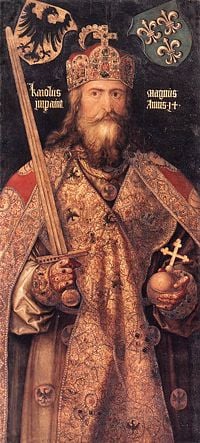
Childeric I (437-481) the first king of the Merovingian Franks, established his capital at Tournai, while his son Clovis I (466–511) extended the kingdom to include much of Gaul, and converted to Christianity. Christian scholars, mostly Irish monks, preached Christianity and started a wave of conversion. The Merovingians were succeeded by the Carolingian Dynasty. After Charles Martel (686-741) countered the Moorish invasion from Spain, the King Charlemagne (742/7-814) who was born close to Liège) brought a huge part of Europe under his rule and was crowned the "Emperor of the Holy Roman Empire" by the Pope Leo III (800 in Aachen).
Arnulf of Carinthia (850-899) defeated the Vikings in 891 near Leuven. The Frankish lands were eventually divided into France and the Holy Roman Empire. The parts of the County of Flanders stretching out west of the river Scheldt (Escaut in French) became part of France during the Middle Ages, but the remainders of the County of Flanders and the Low Countries were part of the Holy Roman Empire.
As the Holy Roman Emperors lost effective control of their domains in the eleventh and twelfth centuries, the territory more or less corresponding to the present Belgium was divided into mostly independent feudal principalities: the County of Flanders, Marquisate of Namur, Duchy of Brabant, County of Hainaut, Duchy of Limburg, Luxemburg, and the Bishopric of Liège. The rulers of these—both secular and spiritual—had a feudal relationship with the German king (the Holy Roman emperor). The count of Flanders held most of his land as the vassal of the French king, with the eastern part of his county being held in fealty to the German king.
During the eleventh and twelfth centuries, the Mosan art movement flourished in the region moving its centre from Cologne and Trier to Liège, Maastricht and Aachen. Some masterpieces of this Romanesque art are the shrine of the Three Kings at Cologne Cathedral, the baptistry of Renier de Huy in Liège, the shrine of Saint Remacle in Stavelot, the shrine of Saint Servatius in Maastricht or, Notger's gospel in Liège.
In the thirteenth and fourteenth centuries, many cities gained their independence, there was huge trade within the Hanseatic League, huge gothic cathedrals and city halls were built.
Part of Burgundy
By 1433, most of the Belgian and Luxembourgian territory along with much of the rest of the Low Countries became part of Burgundy under Philip the Good (1396-1467). When Mary of Burgundy, granddaughter of Philip the Good married Maximilian I (1459– 1519), the Low Countries became Habsburg territory. Their son, Philip I of Castile (Philip the Handsome) was the father of the later Charles V (1500–1558). The Holy Roman Empire was unified with Spain under the Habsburg Dynasty after Charles V inherited several domains.
Especially during the Burgundy period (the fifteenth and sixteenth centuries), Ypres, Ghent, Bruges, Brussels, and Antwerp took turns at being major European centers for commerce, industry (especially textiles) and art. The Flemish Primitives were a group of painters active primarily in the Southern Netherlands in the fifteenth and early sixteenth centuries (for example, Van Eyck and van der Weyden). Flemish tapestries hung on the walls of castles throughout Europe.
The Seventeen Provinces
The Pragmatic Sanction of 1549, issued by Holy Roman Emperor Charles V (1500–1558), established the Seventeen Provinces (or the Spanish Netherlands in its broad sense) as an entity separate from the empire and from France. This comprised all of the Netherlands, Belgium, and Luxembourg except for the lands of the Bishopric of Liège. However, the northern region now known as the Netherlands became increasingly Protestant (Calvinistic), while the south remained primarily Catholic. The schism resulted in the Union of Atrecht and the Union of Utrecht in 1579. When Philip II (1527-1598), son of Charles ascended the Spanish throne, he tried to abolish Protestantism.
Eighty Years' War
Portions of the Netherlands revolted, beginning the Eighty Years' War (1568–1648), between the Netherlands and Spain. For the conquered Southern Netherlands the war ended in 1585 with the Fall of Antwerp. This can be seen as the start of Belgium as one region. That same year, the northern Low Countries (i.e. the Netherlands proper) seized independence in the Oath of Abjuration (Plakkaat van Verlatinghe) and started the United Provinces and the Dutch Golden Age. For them, the war lasted until 1648 (the Peace of Westphalia), when Spain recognized the independence of the Netherlands, but held onto the loyal and Catholic region of modern-day Belgium which was all that remained of the Spanish Netherlands.
Spanish rule
The Southern Netherlands remained under the rule of the Spanish Hapsburgs (1519-1713), although it enjoyed a large degree of autonomy. A governor-general, usually a Spanish royal family member, represented the king in Brussels. Local leaders held most positions on the Council of State, the Privy Council, and the Council of Finances. The president of the Privy Council became a kind of prime minister. The bishopric of Liège was ruled as a separate principality.
A revolt against Spain in 1567 and subsequent military campaigns harmed industrial activity in the south, and caused merchants and skilled artisans to leave. Amsterdam replaced Antwerp as the chief trading centre of Europe. To rebuild its economic base, Antwerp fostered silk weaving, diamond processing, and the production of fine linen, furniture, and lace. The Brueghels, Peter Paul Rubens and Van Dyck's baroque paintings were created during this period.
Austrian Habsburg rule
In 1700, Charles II (1661–1700) died, ending the Spanish Habsburg dynasty, and a new conflict with France arose. By the Treaty of Utrecht (1713), which ended the War of the Spanish Succession (1701-1714), the territory comprising present-day Belgium and Luxembourg (excepting Liège) passed under the sovereignty of the Austrian Habsburg, the Holy Roman emperor Charles VI (1685–1740). The Austrians allowed political autonomy, introduced more efficient administration, rationalized public finances, and improved the country's infrastructure.
Charles VI died in 1740, and the southern Netherlands passed to his daughter, the Holy Roman Empress Maria Theresa (1717-1780). The War of the Austrian Succession (1740-1748) resulted in a French occupation in 1744. The Treaty of Aix-la-Chappell (1748) restored Austrian rule. During the regime of empress Maria Theresa, increased agricultural productivity, especially the spread of potato cultivation, coincided with population growth, and the development of various industries.
Brabant revolution
Influenced by the Enlightenment, Habsburg Emperor Joseph II (1741-1790), pushed through a series of large-scale reforms in the Austrian Netherlands in the 1780s, designed to modernize and centralize the political, judicial and administrative system. The old decentralized system would be replaced with a uniform judicial system for the whole empire, and the independent provinces of the Austrian Netherlands were to be replaced with nine kreitsen and 35 districten. Joseph also secularized the education system and reorganized or abolished a number of religious orders.
In 1789, a popular revolt broke out in the Austrian Netherlands in reaction against the emperor's centralizing policies. Two factions appeared: the Statists who opposed the reforms, and the Vonckists, named for Jan Frans Vonck, who initially supported the reforms but then joined the opposition. The uprising started in Brabant, which in January 1789 declared it no longer recognized the emperor's rule, in what is called the Brabant Revolution. The leader of the Statisten faction, Hendrik Van der Noot, crossed the border into the Dutch Republic and raised a small army in Breda in Staats-Brabant, the northern (Dutch) part of Brabant.
The revolution had support in the towns, but peasants supported the Austrians. When emperor Leopold II (1747-1792), had imperial troops reoccupy Brussels on December 2, 1790, he encountered no opposition from the masses. The Statists briefly looked to revolutionary France for support.
French rule
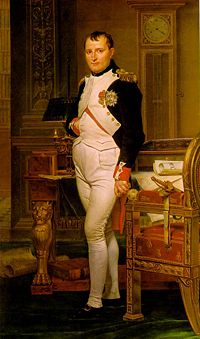
The First French Republic invaded and annexed the Southern Netherlands in late 1795, dividing the territory into nine united départements making it a part of France. The Bishopric of Liège was dissolved, and its territory was divided over the départements Meuse-Inférieure and Ourte. Austria confirmed the loss of the Austrian Netherlands by the Treaty of Campo Formio, in 1797. Under French rule, administration was centralized, aristocratic privileges abolished, and the French civil code was introduced. Military conscription provoked a peasants' revolt (1798–1799). A concordat with the papacy regulated the position of the clergy. The Industrial Revolution reached Belgium at the end of the eighteenth century. Mechanization made Ghent (cotton mills) and Verviers (woolen mills) the leading textile centers of the country, while the coal and metal industries expanded.
Battle of Waterloo
In 1814, Napoleon Bonaparte (1769–1821) was forced to abdicate by the Allies and was exiled to Elba, ending the French period. However, Napoleon managed to escape from Elba and quickly returned to power during the Hundred Days. Napoleon knew that his only chance of remaining in power was to attack the existing Allied forces in Belgium before they were reinforced. He crossed the Belgian frontier with two armies and attacked the Prussians under the command of General Gebhard Leberecht von Blücher at the Battle of Ligny on June 16, 1815. Meanwhile, Ney engaged the forces of the Duke of Wellington and the Prince of Orange in the Battle of Quatre Bras on the same day.
Napoleon was finally defeated by the Duke of Wellington and Gebhard Leberecht von Blücher at Waterloo in present-day Belgium on June 18, 1815. Napoleon's strategy failed and his army was driven from the field in confusion, by a combined Allied general advance. The next morning the Battle of Wavre ended in a hollow French victory. Napoleon was forced to surrender and was exiled to Saint Helena.
King William I of the Netherlands had the Butte du Lion erected on the battlefield of Waterloo to commemorate the location where his son, William II of the Netherlands (the Prince of Orange), was knocked from his horse by a musket ball to the shoulder and as a tribute to his courage. It was completed in 1826. The younger William had fought as commander of combined Dutch and Belgian forces at the Battle of Quatre Bras and the Battle of Waterloo.
United Kingdom of the Netherlands
After Napoleon's defeat at Waterloo in 1815, the major victorious powers (Britain, Austria, Prussia, Russia) agreed at Congress of Vienna, in June of that year, to reunite the former Austrian Netherlands and the former Dutch Republic, creating the United Kingdom of the Netherlands, which was to serve as a buffer state against any future French invasions. Protestant Prince William of Orange ascended the throne on March 16, 1815, under the title William I (1772–1843). Most of the small and ecclesiastical states in the Holy Roman Empire were given to larger states at this time, and this included the Prince-Bishopric of Liège which became now formally part of the United Kingdom of the Netherlands.
The two parts of The Netherlands had developed in different ways since the sixteenth century, when the two regions had last been under one administration. The north was commercial, Protestant and Flemish (Netherlandic) speaking, and the south was industrial, Roman Catholic, and partly French speaking. The elite spoke French. Dutch William I made Dutch the official language, and promulgated a constitution that gave Belgium and Holland the same number of representatives in the assembly despite Belgium's population being twice that of the Dutch area. The king encouraged the industrialization of the south, invested in roads and canals, set up universities in Ghent and Liège, and put the university at Louvain under state control to reduce Catholic influence.
Belgian Revolution
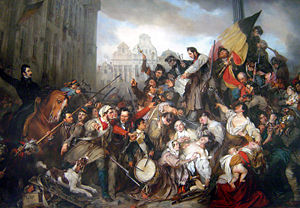
The Belgian Revolution was a conflict in the United Kingdom of the Netherlands that began with a riot in Brussels in August 1830 and eventually led to the establishment of an independent, Roman Catholic and neutral Belgium (William I, king of the Netherlands, would refuse to recognize a Belgian state until 1839, when he had to yield under pressure by the Treaty of London).
The Belgian Revolution had many causes; principally the treatment of the French-speaking Catholic Walloons in the Dutch-dominated United Kingdom of the Netherlands, and the difference of religion between the Belgians and their Dutch king. The main cause of the Belgian Revolution was the domination of the Dutch over the economic, political, and social institutions of the United Provinces. The Belgians had little influence over the economy and resented Dutch control. At the most basic level, the Dutch were for free trade, while less-developed local industries in Belgium called for the protection by way of tariffs. Free trade lowered the price of bread, made from wheat imported through the reviving port of Antwerp; at the same time, these imports from the Baltic depressed agriculture in Belgian grain-growing regions.
Catholic partisans watched with excitement the unfolding of the July Revolution in France, details of which were swiftly reported in the newspapers. The opening phase was a riot the night of August 25, 1830, following a performance of Daniel Auber's sentimental and patriotic opera La Muette de Portici, a tale suited to fire National Romanticism, for it was set against Masaniello's uprising against the Spanish masters of Naples in the seventeenth century.
The revolutionaries demanded separate administrations for the northern and southern Netherlands, but the actions of radical patriots and the unyielding attitude of the king meant a provisional Belgian government was established on September 25, and this government proclaimed the country's independence on October 4. William I prepared for war, but on December 20 the great powers imposed an armistice. On January 20, 1831, an international conference in London recognized an independent, Catholic, and neutral Belgium under a provisional government and a national congress.
Independent Belgium
On July 21, 1831, Prince Leopold of Saxe-Coburg, ascended the throne. Some days later, the Dutch army invaded. Belgium had no army, so the London Conference agreed to intervention by the French army, forcing the Dutch to withdraw. The conference divided the provinces of Limburg and Luxembourg between Belgium and The Netherlands. Eastern Luxembourg became the Grand Duchy of Luxembourg, while the western half became a Belgian province. The Treaty of London in 1839 recognized an independent and neutral Belgium in its borders of 1838. Since the installation of Leopold I (1790-1865) as king in 1831, Belgium has been a constitutional monarchy and parliamentary democracy, although it was initially an oligarchy ruled mainly by the Catholic Party and the Liberals.
Independent Belgium lost the Dutch market, so the Belgian government in 1835 inaugurated a railway line between Brussels and Malines (Antwerp), completed the Antwerp-Cologne line in 1843, and in 1844 a favorable trade agreement with the German Zollverein (“Customs Union”). Modernized infrastructure stimulated industrial investment. Belgian banks financed Walloon heavy industry, creating a new industrial banking system, soon to be copied by the French, the Germans, and later the English-speaking world. But the Ghent cotton industry faced stiff competition from Britain, the Flemish woollen producers had lost out to competition from Verviers and northern France, and famine caused by poor grain harvests and potato blight struck between 1844 and 1846.
In 1846, middle-class, anticlerics formed a national liberal party independent of the Unionist movement which drove the revolution. The first Liberal government came to power in 1847, and withstood the revolutionary pressure that shook Europe in 1848. While in government, the Liberals curtailed the church's influence in charity and education—sparking the so-called School War when religious education was eliminated from public primary schools. The School War triggered a conservative backlash that gave the Catholics a majority in both chambers of the parliament in the elections of 1884.
The Berlin Conference of 1885 gave the Congo Free State to King Leopold II as his private possession. In 1908, it was ceded to Belgium as a colony, henceforth called the Belgian Congo. The integration of traditional economies in the Congo within the framework of the modern, capitalist economy was brilliantly executed; for example, several railroads were built through dense regions of jungle. Leopold's fortune was greatly increased through the proceeds of Congolese rubber, which had never been mass-produced in such quantities. But many atrocities were committed in the colony, especially when it still was Leopold II's personal possession. The behavior of the Belgian colonists in Congo remains a conflict-laden topic in Belgium.
World War I
World War I was a global military conflict which took place primarily in Europe from 1914 to 1918. Over 40 million casualties resulted, including approximately 20 million military and civilian deaths. The Entente Powers, led by France, Russia, the British Empire, and later Italy (from 1915) and the United States (from 1917), defeated the Central Powers, led by the Austro-Hungarian, German, and Ottoman Empires.
The neutrality of Belgium was violated in 1914 when Germany invaded Belgium as part of the Schlieffen Plan, which was the German General Staff's strategic plan for victory both on the Western Front against France and against Russia in the east, by taking advantage of expected differences in the three countries' speed in preparing for war. The Germans were stopped by the Allies at the front-line along the Yser, the battle of the Yser. King Albert I stayed in Belgium with his troops to lead the army while the government withdrew to Le Havre, France.
Much of the Western Front fighting of World War I occurred in western parts of Belgium. Flanders was the location of some of the greatest losses of life of the First World War including the first in 1914, and the four-stage second battles of Ypres in 1915. The poppies that sprang up from the battlefield were immortalized in the poem In Flanders Fields, and have become an emblem of human life lost in war. Belgium lost 104,987 people to that war.
During World War I, Germany supported the Flemish Activists, a radical nationalist group in a bid to profit from Flemish-Walloon antagonism. Most Flemings rejected collaboration and refused to recognize either the Council of Flanders, founded during the occupation, or the University of Ghent, changed during the occupation to a Flemish-language institution.
The interwar period
The Treaty of Versailles (1919), a peace treaty that officially ended World War I, had subjected several German border towns, most notably Eupen and Malmedy, to a plebiscite, which led to their annexation by Belgium in 1925. After the defeat of Germany, the two former German colonies, Rwanda and Burundi, were mandated to Belgium by the League of Nations, of which it was a founding member. In 1920, Belgium signed a treaty of military assistance with France, and in 1921, concluded an economic union with Luxembourg. Suffrage was extended to all men over the age of 21. Catholic-Liberal coalition governments predominated in the interwar period, while the Socialist Party, which had emerged in the late nineteenth century, became prominent.
The experiences of the Dutch-speaking soldiers on the front led by French speaking officers catalyzed a desire for Flemish emancipation. Perceived discrimination against Flemish soldiers at the Yser front during the war, as well as a lack of official response to postwar Flemish demands, resulted, in 1930, in the Belgian government making Flanders and Wallonia unilingual regions, with only Brussels and its surroundings remaining bilingual.
The war had wrecked parts of the country, and the Germans had dismantled Walloon heavy industry. Belgium did not receive the war reparations due from Germany, which had a significant effect on the Belgium economy, as did soaring exchange rates, which generated a serious flight of capital, an imbalance of payments, and rampant inflation. The stock market crash of 1929 in the United States further jolted the Belgian economy.
After a period of alliance with France, King Leopold III (1901-1983), who succeeded his father, Albert I, in 1934, advocated a policy of neutrality, although at the same time the government constructed a line of defense from Namur to Antwerp.
World War II
World War II was a worldwide military conflict, which split the majority of the world's nations into two opposing military alliances: the Allies and the Axis Powers. Spanning much of the globe, World War II resulted in the death of over 70 million people, making it the deadliest conflict in human history.
On May 10, 1940, Nazi Germany invaded Belgium, as well as Luxembourg, and The Netherlands during the Blitzkrieg offensive, which involved bombardment followed by a fast surprise attack by mobile forces. Belgium capitulated after 18 days. France and Britain sent troops into Belgium but French troops surrendered and British troops retreated from the continent via Dunkirk, in France. The Belgian government fled to France, then to London. King Leopold III, as commander in chief of the army, remained in Belgium and was confined to his palace by the Germans, who remained there until Allied forces reached Belgium on September 3, 1944. The Belgian underground army prevented the destruction of the port of Antwerp. Belgium was the location of the Ardennes Offensive, also known as the Battle of the Bulge, a surprise attack by the German army on December 16, 1944, seeking to split the British and American Allied line in half, capturing Antwerp, Belgium, and then proceeding to encircle and destroy four Allied armies, forcing the Western Allies to negotiate a peace treaty. The German objectives ultimately were unrealized. In the wake of the defeat, many experienced German units were left severely depleted of men and equipment, as German survivors retreated to the defenses of the Siegfried Line. Belgium lost 86,100 people to that war.
From 1945
War damage was limited, and Belgium showed an economic resurgence after the war. Investigation of wartime collaboration with the Nazis resulted in purges and detentions of numerous people. The Communist Party, which had been linked with the resistance movement, took part in coalition governments between 1944 and 1947.
But political stability deteriorated over the “royal question.” In the absence of King Leopold III, the government, in September 1944, conferred the regency on the king's brother, Prince Charles, so Leopold remained in exile until the royal question was resolved. The Flemish and the Christian Democrats supported the king's return, while the Walloons, the Socialists and Liberals opposed it. Although a referendum in 1950 showed 58 percent supported the return of the sovereign, when the king returned that year, Walloon country came to the brink of civil war. From August 1950, Leopold's eldest son, Prince Baudouin (1930-1993), ruled temporarily in his place until July 1951, when Leopold abdicated and Baudouin became king.
After World War II, Belgium joined NATO, headquartered at Brussels, and formed the Benelux group of nations with the Netherlands and Luxembourg. Belgium became one of the six founding members of the European Coal and Steel Community in 1951, and of the 1957 established European Atomic Energy Community and European Economic Community. The latter is now the European Union, for which Belgium hosts major administrations and institutions, including the European Commission, the Council of the European Union, and the extraordinary and committee sessions of the European Parliament.
During the 1950s, opposition to colonial rule in the Belgian Congo led to large-scale demonstrations in Léopoldville. The Belgian Congo gained independence in 1960 during the Congo Crisis; Ruanda-Urundi followed two years later.
Federal state created
Linguistic and economic tensions intensified between Flemings and Walloons. Massive strikes in Wallonia in early 1961 resulted in parliament defining a linguistic border in 1962–1963, with a bilingual area around Brussels. The bilingual University of Louvain was divided into a Flemish-speaking campus on Flemish territory and a French-speaking campus on Walloon territory in 1969–1970. The parliament gave cultural autonomy to the Flemish and Walloon regions in 1971, and the constitution was revised in 1980 to create an independent administration within each region, extended in 1988–1989 to cover the economy and education. That revision made the bilingual metropolitan area of Brussels a third independent region with its own administration. Thus Belgium changed into a federal state. The St Michael's Agreement, of September 1992, called for the division of Brabant into Flemish Brabant and Walloon Brabant. King Baudouin died on July 31, 1993, to be succeeded by his brother, Albert II.
Political crisis
A string of Christian Democrat coalition governments from 1958 was broken in 1999 after the first dioxin crisis, a food contamination scandal which led to the establishment of the Belgian Food Agency. The government led by Prime Minister Guy Verhofstadt from 1999 to 2007 achieved a balanced budget, some tax-reforms, a labor-market reform, scheduled nuclear phase-out, and instigated legislation allowing more stringent war crime and more lenient soft drug usage prosecution. Restrictions on withholding euthanasia were reduced and same-sex marriage legalized. The government promoted active diplomacy in Africa. Verhofstadt's coalition fared badly in the elections of 2007. Since then, as of November 2007, the country has been experiencing a long lasting political crisis. This crisis is such that many observers have speculated a possible partition of Belgium.
Government and politics
Constitutional structure
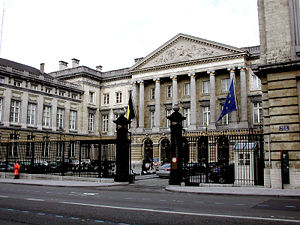
Belgium is a constitutional, popular monarchy and a parliamentary democracy. The Constitution of Belgium was established in 1831, and revised in 1970 in response to conflict between the Dutch-speaking and French-speaking communities, to diffuse power to the communities and the regions. It was revised again in 1993, creating a federal state. The constitution is the primary source of law and the basis of the political system in Belgium.
The king is the constitutional head of the Belgian state and holds office for life. As head of state, the king plays a ceremonial and symbolic role. Following legislative elections, the leader of the majority party or the leader of the majority coalition is usually appointed prime minister by the monarch and then approved by parliament.
The bicameral parliament consists of a senate of 71 members, 40 of whom are directly elected by popular vote and 31 indirectly elected, to serve four-year terms, and a Chamber of Deputies of 150 members who are directly elected by popular vote on the basis of proportional representation to serve four-year terms. Suffrage is universal to those aged 18 years and over. Voting is compulsory so more than 90 percent of the population participates.
Belgium is a federation with a multi-party political system, with numerous parties have no chance of gaining power alone, and therefore must work with each other to form coalition governments. Almost all Belgian political parties are divided into linguistic groups, either Dutch-speaking parties, Francophone parties, or germanophone parties. The Flemish parties operate in Flanders and in the Brussels-Capital Region. The Francophone parties operate in Wallonia and in the Brussels-Capital Region. There are also parties operating in the comparatively small German-speaking community.
Political parties are thus organized along community lines, especially for the three main communities. There are no representative parties active in both communities. Even in Brussels, all parties presenting candidates are either Flemish parties, or French-speaking. As such, the internal organization of the political parties reflects the fundamentally dual nature of Belgian society. There are no significant parties left who exist, or operate on a national, Belgian level.
From the creation of the Belgian state in 1830 and throughout most of the nineteenth century, two political parties dominated Belgian politics: the Catholic Party (Church-oriented and conservative) and the Liberal Party (anti-clerical and progressive). In the late nineteenth century the Labour Party arose to represent the emerging industrial working class.
Belgium is a highly unionized country, and organized labor is a powerful influence in politics. About 53 percent of all private sector and public service employees are labor union members. Not simply a "bread and butter" movement in the American sense, Belgian labour unions take positions on education, public finance, defense spending, environmental protection, women's rights, abortion, and other issues. They also provide a range of services, including the administration of unemployment benefits. Belgium's three principal trade union organizations are the Confederation of Christian Trade Unions (1,705,000 members), the General Federation of Belgian Labour (1,198,000 members) and the General Confederation of Liberal Trade Unions of Belgium which has 230,000 members.
The judicial system is based on civil law and originates from the Napoleonic code. It has a judicial review of legislative acts. It accepts compulsory ICJ jurisdiction, with reservations. The Court of Appeals is one level below the Court of Cassation, an institution based on the French Court of Cassation. The Court of Cassation is the most important court in Belgium. Judges are appointed for life by the Belgian monarch.
Political authority
The federal state retains a considerable "common heritage." This includes justice, defense, federal police, social security, nuclear energy, monetary policy and public debt, and other aspects of public finances. State-owned companies include the Post Office and Belgian Railways. The federal government is responsible for the obligations of Belgium and its federalized institutions towards the European Union and NATO. It controls substantial parts of public health, home affairs and foreign affairs.
Communities exercise their authority only within linguistically determined geographical boundaries. Regions have authority over economy, employment, agriculture, water policy, housing, public works, energy, transport, the environment, town and country planning, nature conservation, credit, and foreign trade. They supervise the provinces, municipalities, and inter-communal utility companies.
Military
The Belgian Armed Forces have about 41,000 active troops. They are organized into one unified structure which consists of four main components: The Army, the Air Force, the Navy, and the Medical Component.
Economy
Belgium operates a modern, private-enterprise economy has capitalized on its central geographic location, highly developed transport network, and diversified industrial and commercial base. It is one of the world's ten largest trading nations. The economy is characterized by a highly productive work force, high GNP, and high exports per capita. The Belgian economy is heavily service-oriented and shows a dual nature: a dynamic Flemish economy, with Brussels as its main multilingual and multi-ethnic centre, and a Walloon economy that lags behind.
The people of Belgium enjoy a high standard of living. Belgium ranks ninth in the 2006 HDI, 24th on The Economist's 2005 world-wide quality-of-life index, and it has an average per capita income that has been estimated at $33,000 for the year 2006, 14th on the IMF list of 179 countries, and comparable to that of the United Kingdom, and Sweden.
Belgium was the first continental European country to undergo the Industrial Revolution, in the early 1800s. Liège and Charleroi rapidly developed mining and steelmaking, which flourished until the mid-twentieth century. However, by the 1840s the textile industry of Flanders was in severe crisis and the region experienced famine from 1846–1850.
After World War II, Ghent and Antwerp experienced a rapid expansion of the chemical and petroleum industries. The 1973 and 1979 oil crises sent the economy into a recession; it was particularly prolonged in Wallonia, where the steel industry had become less competitive and experienced serious decline. In the 1980s and 1990s, the economic centre of the country continued to shift northwards and is now concentrated in the populous Flemish Diamond area.
By the end of the 1980s, Belgian macroeconomic policies had resulted in a cumulative government debt of about 120 percent of GDP. As of 2006, the budget was balanced and public debt was equal to 90.30 percent of GDP. In 2005 and 2006, real GDP growth rates of 1.5 percent and 3.0 percent, respectively, were slightly above the average for the euro area. Unemployment rates of 8.4 percent in 2005 and 8.2 percent in 2006 were close to the area average.
One of the founding members of the European Union, Belgium strongly supports an open economy and the extension of the powers of EU institutions to integrate member economies. In 1999, Belgium adopted the euro, the single European currency, which fully replaced the Belgian franc in 2002. Since 1922, Belgium and Luxembourg have been a single trade market within a customs and currency union: the Belgium-Luxembourg Economic Union.
With few natural resources, Belgium must import substantial quantities of raw materials and export a large volume of manufactures, making its economy unusually dependent on the state of world markets. Exports totaled $283.8-billion in 2006. Export commodities included machinery and equipment, chemicals, diamonds, metals and metal products, and foodstuffs. Export partners included Germany 19.7 percent, France 16.9 percent, Netherlands 12 percent, UK 7.9 percent, and the US 6.2 percent, Italy 5.2 percent. Imports totaled $279.9-billion in 2006. Import commodities included machinery and equipment, chemicals, diamonds, pharmaceuticals, foodstuffs, transportation equipment, and oil products. Import partners included Netherlands 18.3 percent, Germany 17.3 percent, France 11.2 percent, UK 6.6 percent, Ireland 5.7 percent, and the US 5.4 percent.
Demographics
Population
Belgium's total population in 2007 was 10,296,350. Immigration brought its population of foreign origin to 56 percent in 2006. The population density of Belgium is 886 per square mile (342 per square kilometer) – one of the highest in Europe, after that of the Netherlands and some microstates such as Monaco. The median age for the total population of 41.1 years in 2007. Almost all of the Belgian population is urban - 97 percent in 2004. Belgians had an average life expectancy at birth of 78.92 years (75.75 years for males and 82.24 years for females) in 2007.
Ethnicity
The country is ethnically split between its Fleming majority, 58 percent of the population, its Walloonian minority, 31 percent of the population, and about 73,000 Germans. The other 11 percent consists mostly of Europeans, Turks, Moroccans and Algerians.
The terms Fleming and Flemings denote respectively a person and people, and the Flemings or the Flemish or the Flemish people the population forming a community of more than six million people and the majority of all Belgians, of Flanders, the northern half of the country. The native Flemings descend from Germanic tribes, predominantly Franks, and mixed Celtic-Germanic "Gaulish" tribes who had lived in the same region even before Roman times. Flemish culture is defined by its West Germanic language, Dutch, shared with most people in the Netherlands.
The term Walloons refers, in daily speech, to Belgians from Wallonia, roughly the southern half of the country. The name is derived from "walhaz," which was a term used by the ancient Germanic Tribes to refer to "Celtic" people. The heartland of Walloon culture is the Meuse Valley, Dinant, Namur (the regional capital), Huy and Liège. Brussels has been the major town of the region. Under the long Spanish and French rule, the sole official language was French; after independence in 1830 this was maintained, and the Walloon region, being a major coal and steel producing area, developed very quickly into the economic powerhouse of the country. Walloons were therefore politically dominant, and many Flemish immigrants came to work in Wallonia. Between the 1930s and the 1970s, the gradual decline of steel and more especially coal, coupled with the imbalance in investment in service industries and light industry which came to predominate in Flanders, started to tip the balance in the other direction and Flanders became gradually politically dominant, and in their turn Walloon families have moved to Flanders in search of jobs.
The prevalent foreign nationals were Italian (183,021), French (114,943), Dutch (100,700), Moroccan (81,763), Spanish (43,802), Turkish (41,336), and German (35,530).
Religion
Since independence, Catholicism, counterbalanced by strong freethought movements, has had an important role in Belgium's politics. However, Belgium is largely a secular country as the laicist constitution provides for freedom of religion, and the government generally respects this right in practice. Nevertheless, the monarchy has a reputation of deeply-rooted Catholicism. In 1990, for instance, as the king was constitutionally obliged to sign a law legalizing abortion after it had been passed by both chambers, Baudouin asked the then Christian-Democrat Prime Minister Wilfried Martens to find a way out, causing the parliament to declare him "temporarily unfit to reign," with his consent. On the yearly national holiday, the king and queen and other members of the royal family officially attend Te Deum celebrations.
Symbolically and materially, the Roman Catholic Church remains in a favorable position. According to Belgium's concept of "recognized religions," about 47 percent of the population identify themselves with the Catholic Church. Christianity is traditionally seen as Belgium's majority religion, but by 2004 weekly Sunday church attendance had dropped to about 4 to 8 percent. The second largest religion practiced in Belgium is Islam (3.5 percent). A 2006 survey in Flanders, considered more religious than Wallonia, showed 55 percent to call themselves religious, and that 36 percent believe that God created the world.
According to the most recent Eurobarometer Poll 2005 43 percent of Belgian citizens responded that "they believe there is a god," whereas 29 percent answered that "they believe there is some sort of spirit or life force" and 27 percent that "they do not believe there is any sort of spirit, god, or life force," the third-equal (with Netherlands) highest rate of non-believing after France and the Czech Republic.
Language
Belgium's three official languages are Dutch, spoken by 60 percent of the population, French, spoken by 40 percent, and German, spoken by less than one percent. Both the Dutch spoken in Belgium and the Belgian French have minor differences in vocabulary and semantic nuances from the varieties spoken in the Netherlands and France. Many Flemish people still speak dialects of Dutch in their local environment. Walloon, once the main regional language of Wallonia, is now only understood and spoken occasionally, mostly by elderly people. Its dialects, along with those of Picard, are not used in public life. Belgium is a country where language is a major political issue. Despite numerous constitution revisions, by 2007 the matter had not been settled.
Men and women
The gap between men and women in the work place has been narrowing, especially among younger generations. Part-time jobs in services have increased, and more women than men work part-time jobs. Belgian women earn on average 91 percent of a man's salary, the lowest pay gap in the European Union.
Marriage and the family
There are no social or ethnic barriers to marriage. People choose their own marriage partners, young people marry and have children less often and later than former generations, and the divorce rate has increased to about 30 percent. The domestic unit is composed of a nuclear family with up to three children, although immigrants from North Africa often have more children. Women do more of the domestic work. Regarding inheritance, the children inherit equally.
Education
Education is compulsory from six to eighteen for Belgians, but many continue to study until about 23 years of age. Among OECD countries in 2002, Belgium had the third-highest proportion of 18–21-year-olds enrolled in postsecondary education, at 42 percent. Highly politicized conflicts between freethought and Catholic segments of the population during the 1950s caused a split in educational organization. A secular branch of schooling is controlled by the community, the province, or the municipality, while religious, mainly Catholic branch education, is organized by religious authorities, although subsidized and supervised by the community.
Free pre-primary schooling is provided to every child from the age of two years six months. Although it is not compulsory, more than 90 percent of all children in the age category attend pre-school. Children start primary school aged six and remain there for six years. The subjects are generally the same at all schools. Primary schooling is free and age is the only entrance requirement. Attendance at secondary school starts at age 12 and lasts to age 18. Here they have to choose a direction, depending on their skill level and interests. Secondary school is divided into four general types: General secondary education, technical, vocational, and art. Higher education in Belgium includes university and polytechnic. Anybody with a qualifying diploma of secondary education is free to enroll at any institute of higher education, except for medicine/dentistry, arts or engineering sciences, which have specific entrance exams.
Regarding literacy, 99 percent of the total population over the age of 15 could read and write in 2003.
Culture
Architecture
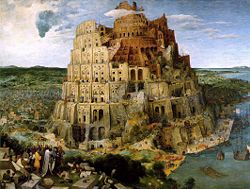
by Pieter Brueghel the Elder,
in Vienna's Kunsthistorisches Museum.
Belgium has a number of medium-size and small cities, centered on rows of terraced houses built among ancient churches and marketplaces. There are many old monuments visible in Belgium, like the romanesque Collégiale Saint-Gertrude de Nivelles (1046) and Cathédrale Notre-Dame de Tournai, gothic Antwerp cathedral (fifteenth century) and baroque Brussels Grand' Place. In the nineteenth century, working-class cities were built in mining and industrial areas. At the end of the nineteenth century and at the beginning of the twentieth century, the historicism style began to dominate the urban Belgian landscape (e.g. Justice Palace of Brussels, 50th-Anniversary Park in Brussels). Brussels became one of the major European cities for the development of the Art Nouveau style, with Victor Horta and Henry van de Velde the main exponents. The Manneken Pis, a Brussels landmark, is a small bronze fountain sculpture depicting a naked little boy apparently urinating into the fountain's basin.
Art
Famous names include the Flemish artists Jan van Eyck (1385-1441), Rogier van der Weyden (1400-1464) and, Pieter Brueghel the Elder (1525-1569) as well as Lambert Lombard (1505-1556) and Theodore de Bry (1528-1587) from Liège. The historical artistic production of the Flemish before the early seventeenth century Baroque style of Peter Paul Rubens (1577-1640) and Anthony van Dyck (1599-1641) is often not distinguished from that of the Dutch. In the southern Netherlands it gradually declined thereafter, although high quality tapestry continued to be created until well into the eighteenth century.
During the nineteenth and twentieth centuries many original romantic, expressionist and surrealist Belgian painters emerged, including Egide Wappers (1803-1874), James Ensor (1860-1949), Constant Permeke (1886-1952) and René Magritte (1898-1967). The avant-garde CoBrA movement appeared in the 1950s, while the sculptor Panamarenko remains a remarkable figure in contemporary art. The multidisciplinary artist Jan Fabre and the painter Luc Tuymans are other internationally renowned figures on the contemporary art scene.
Cuisine
Belgium is a nation of Gourmands rather than Gourmets which translates into big cuisine rather than fine cuisine. In reality this means that along with big portions, you get pretty good quality and a kind of unpretentiousness. It is often said Belgium serves food with the quantity of Germany and the quality of France.
"French" fries, which the Belgians consider themselves to have invented, are very popular. They are called frieten in Flemish or frites in French. The best place to enjoy Belgian frites is at a frituur (friterie in French or informally frietkot in Flemish) which is a temporary construction usually strategically placed in busy squares.
Typical dishes include
- Mosselen-Friet/Moules Frites or mussels and chips.
- Konijn in Geuze or Lapin à la Gueuze. Rabbit in Geuze, which is a spontaneously fermented, sour beer from the area around Brussels.
- Stoemp, or potato mashed with other vegetables, often served with sausage.
- Salade Liégeoise, (Luikse sla) a salad with green beans, pieces of bacon, onions and vinegar, associated with Liége.
- Vlaamse stoofkarbonaden (Carbonnades Flamandes) or Flemish beef stew, similar to the French Beef Bourguignon but made with beer instead of red wine.
- Waterzooi, a mild casserole of chicken (or occasionally fish) in cream, associated with Ghent.
- Paling In 't Groen (Anguilles au vert). Eels in a green sauce of mixed herbs.
- Gegratineerd witloof/Chicon Gratin, Belgian endives baked in melted cheese.
- Slices of rustic bread (boterhammen/tartines) and an uncovered spread, often pâté or soft cheese, served on a board and eaten with knife and fork. A typical variety is boterhammen met platte kaas en radijsjes, quark with sliced radishes on such bread.
- The Ardennes is notable for Charcuterie, or cold meat products, particularly paté, which may be made of game such as wild boar.
- Waffles, sometimes eaten as a street snack.
- Chocolate, particularly pralines (filled chocolates).
Another Belgian speciality is beer. Although a comparatively small country, there are a large number of beers available in a range of different styles. Almost every different beer has its own unique drinking vessel, usually a glass of some description. Several home and restaurant dishes use typical Belgian beers.
Folklore
Folklore plays a major role in Belgium's cultural life: the country has a comparatively high number of processions, cavalcades, 'kermesse', and other local festivals, nearly always with an originally religious background. The Carnival of Binche with its famous Gilles, and the 'Processional Giants and Dragons' of Ath, Brussels, Dendermonde, Mechelen and Mons are recognized by UNESCO as Masterpieces of the Oral and Intangible Heritage of Humanity.
Other examples are the Carnival of Aalst; the still very religious processions of the Holy Blood in Bruges, Virga Jesse in Hasselt, and Hanswijk in Mechelen; the August 15 festival in Liège; and the Walloon festival in Namur. Originated in 1832 and revived in the 1960s, the Gentse Feesten have become a modern tradition. A major non-official holiday is the Saint Nicholas Day, a festivity for children and, in Liège, for students.
Literature
Belgian literature as such does not exist. Flemish share their authors with the Dutch (see Dutch literature, Flemish literature), and French-speakers with the French which tend to confuse people on Belgian authors. Several great French authors went to Belgium for refuge (e.g. Apollinaire, Baudelaire, Rimbaud, Verlaine) and conversely, top French-speaking writers often settle in Paris (e.g. Simenon, Amélie Nothomb). It is also sometimes difficult to cast Belgian authors into the French or Flemish category because many Flemish authors have written in French (e.g. Suzanne Lilar) and spent a large part of their lifes outside of Flanders or of Belgium. The confusion is also enhanced by the fact that many French-speaking individuals are coming from originally Dutch-speaking families (particularly in Brussels, e.g. Jacques Brel).
Belgium has produced several well-known authors such as poets: Guido Gezelle (1830-1899), Emile Verhaeren (1855-1916), Max Elskamp (1862-1931), Maurice Maeterlinck (1862-1949), Paul van Ostaijen (1896-1926), Henri Michaux (French born and educated in Belgium, (1899-1984) and Jacques Brel (1929–1978) and writers: Hendrik Conscience (1812-1883), Charles de Coster (1827-1879), Willem Elsschot (1882-1960), Michel de Ghelderode (1898-1962), Georges Simenon [1903-1989, Louis Paul Boon (1912-1979), Hugo Claus (born in 1929), Pierre Mertens (born in 1939) Ernest Claes (1885-1968), and, Amélie Nothomb (born in 1967).
Music
The vocal music of the Franco-Flemish School developed in the southern part of the Low Countries and was an important contribution to Renaissance culture. Most significant musically was the pervasive influence of musicians from the Low Countries, whose domination of the musical scene during the last half of the fifteenth century is reflected in the period designations the Netherlands school and the Franco-Flemish school.
Many important classical composers were born in Belgium. The most famous is undoubtedly César Franck but Henri Vieuxtemps, Eugène Ysaÿe, Guillaume Lekeu and Wim Mertens are also noteworthy. The nineteenth and twentieth-centuries witnessed the appearance of major violinists, such as Henri Vieuxtemps, Eugène Ysaÿe and Arthur Grumiaux.
Well-known singers include pioneer Bobbejaan Schoepen, a pioneer of varieté and pop music, Jacques Brel, Johnny Hallyday (before he became French), Arno, and Maurane.
Adolphe Sax, the inventor of the saxophone, was born in Belgium. The country has also a very active jazz scene that is achieving international recognition with bands like Aka Moon, Maak's Spirit and Octurn. Harmonicist Toots Thielemans and guitarist Philip Catherine are probably the best known Belgian jazz musicians.
Hooverphonic, formed in the mid-1990s, is a Belgian pop / trip hop band that achieved international recognition through their inclusion on the soundtrack Bernardo Bertolucci's 1996 film Io Ballo da Sola (English: Stealing Beauty). Other popular Belgian pop music comes from Axelle Red, Vaya Con Dios, and K's Choice.
Belgium has also influenced electronic music with a.o. Front 242, Praga Khan (also known as Lords of Acid) and 2 Many DJs, and rock music with dEUS. Belgian hip-hop started with the rise of Starflam, CNN (a Brussels-based crew) and 't Hof van Commerce in the mid 1990s.
Science and technology
Contributions to the development of science and technology have appeared throughout the country's history. The sixteenth century Early Modern flourishing of Western Europe included cartographer Gerardus Mercator, anatomist Andreas Vesalius, herbalist Rembert Dodoens, and mathematician Simon Stevin among the most influential scientists. In the first half of the seventeenth century, the Walloon method of making bar iron found its way to Sweden where it remained in use for more than 260 years.
The quickly developed and dense Belgian railroad system caused major companies like Brugeoise et Nivelles (now the BN division of Bombardier) to develop specific technologies, and the economically important very deep coal mining in the course of the First Industrial Revolution has required highly reputed specialized studies for mine engineers.
The end of the nineteenth century and the twentieth saw important Belgian advances in applied and pure science. The chemist Ernest Solvay and the engineer Zenobe Gramme gave their names to the Solvay process and the Gramme dynamo, respectively, in the 1860s. Georges Lemaître is credited with proposing the Big Bang theory of the origin of the universe in 1927. Three Nobel Prizes in Physiology or Medicine were awarded to Belgians: Jules Bordet in 1919, Corneille Heymans in 1938, and Albert Claude and Christian De Duve in 1974. Ilya Prigogine was awarded the Nobel Prize in Chemistry in 1977.
Notes
- ↑ Error on call to template:cite web: Parameters url and title must be specified. The World Factbook. CIA.
- ↑ Total population as of January. Eurostat. Retrieved December 6, 2011.
- ↑ 3.0 3.1 3.2 3.3 Error on call to template:cite web: Parameters url and title must be specified. International Monetary Fund.
- ↑ Human Development Report 2010 (PDF). United Nations (2010). Retrieved December 7, 2011.
ReferencesISBN links support NWE through referral fees
- Arblaster, Paul. A history of the Low Countries. (Palgrave essential histories.) Basingstoke [England]: Palgrave Macmillan, 2006. ISBN 978-1403948281
- Blom, J. C. H., and Emiel Lamberts. History of the Low Countries. New York: Berghahn Books, 1998. ISBN 978-1571810854
- Cammaerts, Emile. Belgium from the Roman invasion to the present day. (The story of the nations, 67.) London: T.F. Unwin Ltd, 1921. OCLC 2986704
- Cook, Bernard A. Belgium a history. (Studies in modern European history, v. 50.) New York: Peter Lang, 2002. ISBN 0820476471
- Fitzmaurice, John. The politics of Belgium a unique federalism. (Nations of the modern world.) Boulder, CO: Westview Press, 1996. ISBN 978-0813323879
- Hermans, Theo, Louis Vos, and Lode Wils. The Flemish movement a documentary history, 1780-1990. London: Athlone Press, 1992. ISBN 978-0485113686
- Kossmann-Putto, J. A., and E. H. Kossmann. The low countries history of the northern and southern Netherlands. Rekkem: Stitching Ons Erfdeel, 1997. ISBN 9070831201
External links
All links retrieved September 27, 2023.
- Belgium CIA World Factbook.
- Culture of Belgium Countries and Their Cultures.
- Belgium Encyclopaedia Britannica Online.
- Belgium BBC Country Profiles.
- Belgium U.S. Department of State.
- Belgium, entry in the Catholic Encyclopedia 1913.
- The Belgian monarchy Official Site.
- The Belgian federal government Official Site.
- History of Belgium: Primary Documents EuroDocs.
Credits
New World Encyclopedia writers and editors rewrote and completed the Wikipedia article in accordance with New World Encyclopedia standards. This article abides by terms of the Creative Commons CC-by-sa 3.0 License (CC-by-sa), which may be used and disseminated with proper attribution. Credit is due under the terms of this license that can reference both the New World Encyclopedia contributors and the selfless volunteer contributors of the Wikimedia Foundation. To cite this article click here for a list of acceptable citing formats.The history of earlier contributions by wikipedians is accessible to researchers here:
- Belgium history
- History_of_Belgium history
- United_States_of_Belgium history
- Belgian_Revolution history
- Politics_of_Belgium history
- Flemish_people history
- Wallonia history
- Education_in_Belgium history
- Culture_of_Belgium history
- Cuisine_of_Belgium history
The history of this article since it was imported to New World Encyclopedia:
Note: Some restrictions may apply to use of individual images which are separately licensed.
